| Revision as of 16:51, 13 March 2013 editGreekogreeko (talk | contribs)44 edits →GöktürkTag: section blanking← Previous edit | Revision as of 16:56, 13 March 2013 edit undoGreekogreeko (talk | contribs)44 edits →Medieval Turkic EmpiresNext edit → | ||
| Line 668: | Line 668: | ||
| ] continued to be a major military power with a huge army and strong fleet, and was a major cultural and religious center. Byzantium was the stronghold of ] and thus influenced many states. Byzantium fought against the ] to the south, the ] to the north and the Crusaders, who managed to seize Constantinople in 1204. The Byzantines restored their state in 1261, but its strength never recovered and it was eventually destroyed and replaced by the nascent ] in 1453.{{clear}} | ] continued to be a major military power with a huge army and strong fleet, and was a major cultural and religious center. Byzantium was the stronghold of ] and thus influenced many states. Byzantium fought against the ] to the south, the ] to the north and the Crusaders, who managed to seize Constantinople in 1204. The Byzantines restored their state in 1261, but its strength never recovered and it was eventually destroyed and replaced by the nascent ] in 1453.{{clear}} | ||
| =====Medieval |
=====Medieval Turko-Pesian (Iranian) Empires===== | ||
| ====== Uyghur Khaganate ====== | ====== Uyghur Khaganate ====== | ||
Revision as of 16:56, 13 March 2013
Historical powers include great powers, nations, or empires in history.
The term "Great power" represent the most important world powers. In a modern context, recognised great powers came about first in Europe during the post-Napoleonic era. The formalization of the division between small powers and great powers came about with the signing of the Treaty of Chaumont in 1814. A "great power" is a nation or state that, through its great economic, political and military strength, is able to exert power and influence over not only its own region of the world, but beyond to others.
The historical term "Great Nation", distinguished aggregate of people inhabiting a particular country or territory, and "Great Empire", considerable group of states or countries under a single supreme authority, are colloquial; use is seen in ordinary historical conversations (historical jargon).
History
Ancient powers
- 3000 BC – 476 AD
Ancient Near East
Main article: Ancient Near East| Ancient Near East | ||
|---|---|---|
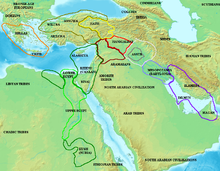
Lighter areas show direct control, darker areas represent spheres of influence. |
The term ancient Near East encompasses the early civilizations during the time roughly spanning the Bronze Age from the rise of Sumer and Gerzeh in the 4th millennium BCE to the expansion of the Persian Empire in the 6th century BCE. The ancient Near East is generally understood as encompassing Mesopotamia (modern Iraq and Syria), Persia (modern Iran), Armenia, the Levant (modern Israel, Jordan, Lebanon, Syria, Palestinian Authority), and at times Anatolia (modern Turkey) and Ancient Egypt.
Sumer and Akkad
Main articles: Sumer and Akkadian EmpireSumer (or Šumer) was one of the early civilizations of the Ancient Near East, located in the southern part of Mesopotamia (modern day Iraq) from the time of the earliest records in the mid 4th millennium BC until the rise of Babylonia in the late 3rd millennium BC. The term "Sumerian" applies to all speakers of the Sumerian language. Sumer (together with Ancient Egypt and the Indus Valley Civilization) is considered the first settled society in the world to have manifested all the features needed to qualify fully as a "civilization", eventually expanding into the first empire in history, the Akkadian Empire.
The profound political, social, and cultural influence imposed upon the Near East by the civilization known as the Ancient Babylonian Empire was the most pervasive in this historical period. The city itself - Babylon - positioned itself as a center of pivotal historical developments for centuries. There were 3 major Babylonian Dynasties: Amorite, Kassite, and Chaldean. This political entity was most predominate within the southern portion of Mesopotamia. It existed as an unremitting rival of the northern Assyrian Mesopotamians. Although it was assaulted and militarily overcome on several occasions,it did exist as a stalwart presence from the latter 3rd millennium BCE to the middle of the 6th century BCE, when it expanded its borders under the auspices of the rather famous Nebuchadnezzar the Great, and thereby overcame the Assyrians swiftly, and established and maintained strongholds throughout the Near Eastern region with a centralized administrative methodology and unyielding system of control. This period would be considered the apex of the Babylonian City-State's dominance in its two-and-a-half millennium history.
Ancient Babylon was officially conquered by the Achemidian Persian Empire in the late 6th century BCE.
Elam
Main article: Elam| Elamite Empire |
|---|
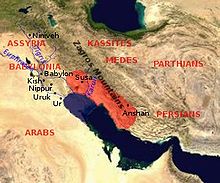 The approximate Bronze Age Elamite Empire extension of the Persian Gulf is shown. |

Elam was situated just to the east of Mesopotamia and was one of the oldest recorded civilizations. Elam was centered in the far west and southwest of modern-day Iran, stretching from the lowlands of Khuzestan and Ilam Province (which takes its name from Elam), as well as a small part of southern Iraq. In the Old Elamite period (Middle Bronze Age), Elam consisted of kingdoms on the Iranian plateau, centered in Anshan, and from the mid-2nd millennium BC, it was centered in Susa in the Khuzestan lowlands.
Elam was part of the early cities of the Ancient Near East during the Chalcolithic (Copper Age). The emergence of written records from around 3000 BC also parallels Mesopotamian history where writing was used slightly earlier. Elamite strength was based on an ability to hold various areas together under a coordinated government that permitted the maximum interchange of the natural resources unique to each region. Traditionally, this was done through a federated governmental structure.
Elamite culture played a crucial role in the Gutian Empire (Persian Empire) especially during the Achaemenid dynasty that succeeded it, when the Elamite language remained among those in official use. The Elamite language is generally treated as an isolate language. As such, the Elamite period is considered a starting point for the history of Iran.
Hurrian kingdoms
Main article: Hurrians| Hurrians |
|---|
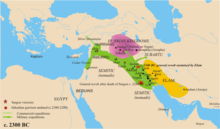 Akkad Elam |
The Hurrians refer to a people who inhabited northern Mesopotamia beginning approximately 2500 BC. The Hurrian kingdoms of the Ancient Near East was in Northern Mesopotamia and its people lived in the adjacent regions during the Bronze Age. The largest and most influential Hurrian nation was the kingdom of Mitanni. The population of the Hittite Empire in Anatolia to a large part consisted of Hurrians, and there is significant Hurrian influence in Hittite mythology.
By the Early Iron Age, the Hurrians had been assimilated with other peoples, except perhaps in the kingdom of Urartu. The Hurrian peoples were not incredibly united, existing as quasi-feudal kingdoms. The kingdom of Mitanni was at its height towards the close of the 14th century BC. By the 13th century BC, the Hurrian kingdoms had been conquered by foreign powers, chiefly the Assyrians.
Assyria
Main article: Assyria| Neo-Assyrian Empire |
|---|
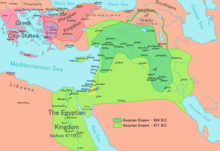 Neo-Assyrian Empire Assyrian Empire - 824 BC Assyrian Empire - 671 BC Other Judah Phrygian Kingdom Lydian Kingdom Greek City States |
In the earliest historical times, the term Assyria referred to a region on the Upper Tigris river, named for its original capital, the ancient city of Assur. Later, as a nation and empire that came to control all of the Fertile Crescent, Egypt and much of Anatolia, the term "Assyria proper" referred to roughly the northern half of Mesopotamia (the southern half being Babylonia), with Nineveh as its capital. The Assyrian homeland was located near a mountainous region, extending along the Tigris as far as the high Gordiaean or Carduchian mountain range of Armenia, sometimes known as the "Mountains of Ashur". The Assyrian kings controlled a large kingdom at three different times in history. These are called the Old, Middle, and Neo-Assyrian kingdoms, or periods. The most powerful and best-known nation of these periods is the Neo-Assyrian Empire, 934-609 BC.
Shalmaneser III (858–823 BC) attacked and reduced Babylonia to vassalage, and defeated Aramea, Israel, Urartu, Phoenicia and the neo Hittite states, forcing all of these to pay tribute to Assyria. Shamshi-Adad V (822-811 BC) inherited an empire beset by civil war which he took most of his reign to quell. He was succeeded by Adad-nirari III who was merely a boy. The Empire was thus ruled by the famed queen Semiramis until 806 BC. In that year Adad-nirari III took the reins of power. After his premature death, Assyria failed to expand further during the reigns of Shalmaneser IV (782-773 BC), Ashur-dan III (772-755 BC) and Ashur-nirari V (754-746 BC).
Under Ashurbanipal (669-627 BC) its domination spanned from the Caucasus Mountains in the north to Nubia, Egypt and Arabia in the south, and from Cyprus and Antioch in the west to Persia in the east. Ashurbanipal destroyed Elam and smashed a rebellion led by his own brother Shamash-shum-ukim who was the Assyrian king of Babylon, exacting savage revenge on the Chaldeans, Nabateans, Arabs and Elamites who had supported him. Persia and Media were regarded as vassals of Ashurbanipal. He built vast libraries and initiated a surge in the building of temples and palaces.
Hittite Empire
Main article: Hittite Empire| Hittite Empire |
|---|
 Hittite region Hittite core region Egyptian region Outlying regions |
The Hittites were an ancient people who spoke an Indo-European language, and established a kingdom centered at Hattusa in north-central Anatolia from the 18th century BC. In the 14th century BC, the Hittite empire was at its height, encompassing central Anatolia, north-western Syria as far as Ugarit, and upper Mesopotamia. After 1180 BC, the empire disintegrated into several independent "Neo-Hittite" city-states, some surviving until as late as the 8th century BC.
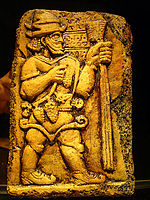
The Hittites were also famous for their skill in building and using chariots, as the Battle of Kadesh demonstrates. The Hittites were pioneers of the Iron Age, manufacturing iron artifacts from as early as the 14th century BC, making them possibly even the first to do so. The Hittites passed much knowledge and lore from the Ancient Near East to the newly arrived Greeks in Europe.
Hittite prosperity was mostly dependent on control of the trade routes and metal sources. Because of the importance of Northern Syria to the vital routes linking the Cilician gates with Mesopotamia, defense of this area was crucial, and was soon put to the test by Egyptian expansion under Pharaoh Rameses II. The outcome of the Battle of Kadesh is uncertain, though it seems that the timely arrival of Egyptian reinforcements prevented total Hittite victory. The Egyptians forced the Hittites to take refuge in the fortress of Kadesh, but their own losses prevented them from sustaining a siege. This battle took place in the 5th year of Rameses (c.1274 BC by the most commonly used chronology).
Ancient Iran
Main article: History of IranMedian Empire
- 678-549 BC
| Median Empire |
|---|
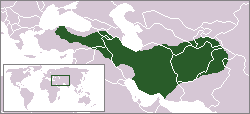 |
The Median Empire was the first empire on the territory of Persia. By the 6th century BC, after having together with the Babylonians defeated the Neo-Assyrian Empire. In Greek references to "Median" people there is no clear distinction between the "Persians" and the "Medians"; in fact for a Greek to become "too closely associated with Iranian culture" was "to become medianized, not persianized". The Median kingdom was a short-lived Iranian state and the textual and archaeological sources of that period are rare and little could be known from the Median culture which nevertheless made a "profound, and lasting, contribution to the greater world of Iranian culture". The Medes were able to establish their own empire, the largest of its day, lasting for about sixty years, from the sack of Nineveh in 612 BC until 549 BC when Cyrus the Great established the Achaemenid Empire by defeating his overlord and grandfather, Astyages, king of Media.
Achaemenid Empire
- 559 BC–330 BC
| Achaemenid Empire |
|---|
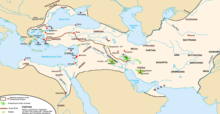 Outlying regions Achaemenid imperial region cities, battles, power centers |
The Achaemenid Empire was the first of the Persian Empires to rule over significant portions of Greater Iran. At the height of its power, the Empire spanned over three continents and was the most powerful empire of his time. It also eventually incorporated the following territories: in the east modern Afghanistan and beyond into central Asia, and parts of Pakistan; in the north and west all of Asia Minor (modern Turkey), the upper Balkans peninsula (Thrace), and most of the Black Sea coastal regions; in the west and southwest the territories of modern Iraq, northern Saudi-Arabia, Jordan, Israel, Lebanon, Syria, all significant population centers of ancient Egypt and as far west as portions of Libya.
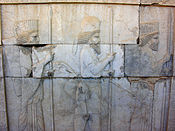
Encompassing approximately 7.5 million square kilometers, the Achaemenid Empire was territorially the largest empire of antiquity. In its time it had political power over neighboring countries, and had high cultural and economic achievements during its lengthy rule over a vast region from its picturesque capital at Persepolis.
Alexander the Great (Alexander III of Macedon) defeated the Persian armies at Granicus (334 BC), followed by Issus (333 BC), and lastly at Gaugamela (331 BC). Afterwards, he marched on Susa and Persepolis which surrendered in early 330 BC. From Persepolis, Alexander headed north to Pasargadae where he visited the tomb of Cyrus, the burial of the man whom he had heard of from Cyropedia.
Parthian Empire
Main article: Parthian Empire| Parthian Empire |
|---|
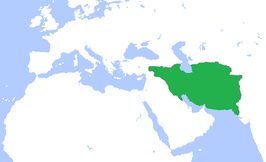 |
The Parthian Empire was the third Iranian Empire. At the height of its power, the empire ruled most of Greater Iran, Mesopotamia and Armenia. But unlike most other Iranian monarchies, the Parthian followed a vassalary system, which they adopted from the Seleucids. The Arsacid culture was not a single coherent state, but instead made up of numerous tributary (but otherwise independent) kingdoms.
The Parthians largely adopted the art, architecture, religious beliefs, and royal insignia of their culturally heterogeneous empire, which encompassed Persian, Hellenistic, and regional cultures. For about the first half of its existence, the Arsacid court adopted elements of Greek culture, though it eventually saw a gradual revival of Iranian traditions. The Arsacid rulers were titled the 'King of Kings', as a claim to be the heirs to the Achaemenid Empire; indeed, they accepted many local kings as vassals where the Achaemenids would have had centrally appointed, albeit largely autonomous, satraps. The court did appoint a small number of satraps, largely outside Iran, but these satrapies were smaller and less powerful than the Achaemenid potentates. With the expansion of Arsacid power, the seat of central government shifted from Nisa, Turkmenistan to Ctesiphon along the Tigris (south of modern Baghdad, Iraq), although several other sites also served as capitals.
Sassanid Empire
Main article: Sassanid Empire| Sassanid Empire |
|---|
 |
The Sassanid Empire is the name used for the fourth Iranian dynasty, and the second Persian Empire (226 - 651). The empire's territory encompassed all of today's Iran, Iraq, Armenia, Afghanistan, eastern parts of Turkey, and parts of Syria, Pakistan, Caucasia, Central Asia and Arabia. During Khosrau II's rule in 590–628 Egypt, Jordan, Palestine, Lebanon were also briefly annexed to the Empire. The Sassanid era, encompassing the length of the Late Antiquity period, is considered to be one of the most important and influential historical periods in Iran. In many ways the Sassanid period witnessed the highest achievement of Persian civilization.
The empire constituted the last great Iranian Empire before the Muslim conquest and adoption of Islam. The Sassanids never mounted a truly effective resistance to the pressure applied by the initial Arab armies. Ctesiphon fell after a prolonged siege. Yazdegerd fled eastward from Ctesiphon, leaving behind him most of the Empire's vast treasury. The Arabs captured Ctesiphon shortly afterward, leaving the Sassanid government strapped for funds and acquiring a powerful financial resource for their own use. A number of Sassanid governors attempted to combine their forces to throw back the invaders, but the effort was crippled by the lack of a strong central authority, and the governors were defeated at the Battle of Nihawānd. The empire, with its military command structure non-existent, its non-noble troop levies decimated, its financial resources effectively destroyed, and the Asawaran knightly caste destroyed piecemeal, was utterly helpless in the face of the invaders. Upon hearing the defeat, Persian nobilities fled further inland to the eastern province of Khorasan.
Ancient Africa
Very few powers emerged in Africa in the early centuries of recorded history, but those that did were quite influential in and outside of their own realms. Ancient Egypt was a power to be contended with by both the Near East, the Mediterranean and Subsaharan Africa. Further to the south, the distant but never reclusive Kingdom of Kush gained a reputation for wealth and military vigor throughout the ancient world. The city states of Mossylon, Malao, Mundus and Opone in Somalia dominated the Red Sea-Indian Ocean trade.
Ancient Egypt
Main article: Ancient Egypt| Ancient Egypt |
|---|
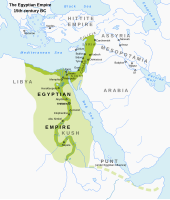 Core Regions Territorial control |
Ancient Egypt was one of the world's first civilizations, with its beginnings in the fertile Nile valley around 3000BC. Ancient Egypt reached the zenith of its power during the New Kingdom (1570–1070 BC) under great pharaohs. It expanded far south into Nubia and held wide territories in the Near East. The combination of a fertile river valley, natural borders that made an invasion unfeasible, and a military able to rise to the challenge when needed, turned Egypt a major power. It was one of the first nations to have a system of writing and large scale construction projects. However, as neighboring civilizations developed militaries capable of crossing Egypt's natural barriers, the Egyptian armies were not always able to repel them and so by 1000 BC Egyptian influence as an independent civilization waned.
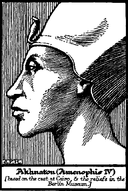
The New Kingdom pharaohs established a period of unprecedented prosperity by securing their borders and strengthening diplomatic ties with their neighbors. Military campaigns waged under Tuthmosis I and his grandson Tuthmosis III extended the influence of the pharaohs to the largest empire Egypt had ever seen. Amenhotep IV ascended the throne and instituted a series of radical and chaotic reforms. Changing his name to Akhenaten, he touted the god Aten as the supreme deity, suppressed the worship of other deities, and attacked the power of the priestly establishment. Moving the capital to the new city of Akhetaten, he turned a deaf ear to foreign affairs and absorbed himself in his new religion and artistic style. After his death, the religion of the Aten was quickly abandoned, and the subsequent pharaohs erased all mention of Akhenaten's Egyptian heresy, now known as the Amarna Period.
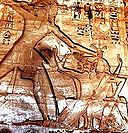
Ramesses the Great ascended the throne, and went on to build more temples, erect more statues and obelisks, and sire more children than any other pharaoh in history. Ramesses led his army against the Hittites in the Battle of Kadesh and, after fighting to a stalemate, finally agreed to the first recorded peace treaty. Egypt's wealth, however, made it a tempting target for invasion, particularly by the Libyans and the Sea Peoples. Initially, the military was able to repel these invasions, but Egypt eventually lost control of Syria and Palestine. The impact of external threats was exacerbated by internal problems such as corruption, tomb robbery and civil unrest. The high priests at the temple of Amun in Thebes accumulated vast tracts of land and wealth, and their growing power splintered the country during the Third Intermediate Period.
The many achievements of the ancient Egyptians include the quarrying, surveying and construction techniques that facilitated the building of monumental pyramids, temples, and obelisks; a system of mathematics, a practical and effective system of medicine, irrigation systems and agricultural production techniques, the first known ships, Egyptian faience and glass technology, new forms of literature, and the earliest known peace treaty. Egypt left a lasting legacy. Its art and architecture were widely copied, and its antiquities carried off to far corners of the world. Its monumental ruins have inspired the imaginations of travellers and writers for centuries. A new-found respect for antiquities and excavations in the early modern period led to the scientific investigation of Egyptian civilization and a greater appreciation of its cultural legacy, for Egypt and the world.
Kush
Main article: Kingdom of Kush| Kingdom of Kush |
|---|
 |
The Kingdom of Kush was the earliest of the Subsaharan states in Africa as well as the first to implement iron weapons. It was heavily influenced by Egyptian colonists, but in 1070 BC it became not only independent of Egypt but a fierce rival. It successfully fought off attempts by Egypt to reconquer it, and it began to extend influence over Upper Egypt. By the end of King Kashta's reign in 752 BC, Thebes was under Kushite control.
A slew of able successors took the rest of Egypt and reigned as the Twenty-fifth dynasty of Egypt stretching Kushite control from central Sudan to modern day Israel. The Kushites did not maintain this empire for long and were beaten back by the Assyrians in 653 BC. However, Kush remained a powerful entity in the region. It continued to meddle in Egyptian affairs and control trade resources originating in Subsaharan Africa. It waged a hard-fought campaign against the Roman Empire (27 BC - 22 BC) under the leadership of Queen Amanirenas, and achieved a more than amicable peace with the young Augustus Caesar. The two states work as allies with Kush lending cavalry support to Rome in its conquest of Jerusalem in 70 AD.
The kingdom of Kush maintained its status as a regional power until its conquest by the Axumite Empire in 350.
Further information: Twenty-fifth Dynasty of EgyptAksumite Empire
Main article: Aksumite EmpireThe Aksumite Empire was an important trading nation in northeastern Africa, growing from the proto-Aksumite period ca. 4th century BC to achieve prominence by the 1st century AD. It was a major player in the commerce between the Roman Empire and Ancient India and the Aksumite rulers facilitated trade by minting their own currency. The state established its hegemony over the declining Kingdom of Kush and regularly entered the politics of the kingdoms on the Arabian peninsula, and would eventually extend its rule over the region with the conquest of the Himyarite Kingdom. It was considered by historians as one of the most powerful military powers in the world.
Ancient Somalia
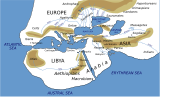
The Macrobians were an ancient people and kingdom situated in the Horn of Africa around the 1st millennium BC. According to Herodotus, the Macrobians practiced an elaborate form of embalming. This, in turn, suggested a knowledge on their part of anatomy and, at the very least, a grasp of the basics of chemistry. The Macrobians preserved the bodies of the dead by first extracting moisture from the corpses, then overlaying the bodies with a type of plaster, and finally decorating the exterior in vivid colors in order to imitate the deceased as realistically as possible. They then placed the body in a hollow crystal pillar, which they kept in their homes for a period of about a year. Macrobia was also noted for its gold, which was so plentiful that the Macrobians shackled their prisoners in golden chains.
The Ancient city-states located in northern Somalia, had a steady trade link with the Ancient Egyptians and exported precious natural resources such as myrrh, frankincense and gum. This trade network continued all the way into the classical era. The city states of Mossylon, Malao, Mundus and Tabae in Somalia engaged in a lucrative trade network connecting Somali merchants with Phoenicia, Ptolemic Egypt, Greece, Parthian Persia, Saba, Nabataea and the Roman Empire. Somali sailors used the ancient Somali maritime vessel known as the 'beden' to transport their cargo.
Greek powers
Main article: Ancient Greece
| Ancient Greece |
| Athens · Sparta · Macedonian Empire |
Ancient Greece is the civilization belonging to the period of Greek history lasting from the Archaic period of the 8th to 6th centuries BC to 146 BC and the Roman conquest of Greece after the Battle of Corinth. At the center of this time period is Classical Greece, which flourished during the 5th to 4th centuries BC, at first under Athenian leadership successfully repelling the military threat of Persian invasion. The Athenian Golden Age ends with the defeat of Athens at the hands of Sparta in the Peloponnesian War in 404 BC. Following the conquests of Alexander the Great, Hellenistic civilization flourished from Central Asia to the western end of the Mediterranean Sea. Classical Greek culture had a powerful influence on the Roman Empire, which carried a version of it to many parts of the Mediterranean region and Europe, for which reason Classical Greece is generally considered to be the seminal culture which provided the foundation of Western civilization.
Athens, after a tyranny in the second half of the 6th century, founded the world's first democracy as a radical solution to prevent the aristocracy regaining power. A citizens' assembly (the Ecclesia), for the discussion of city policy, had existed since the reforms of Draco; all citizens were permitted to attend after the reforms of Solon, but the poorest citizens could not address the assembly or run for office. With the establishment of the democracy, the assembly became the de jure mechanism of government; all citizens had equal privileges in the assembly. However, non-citizens, such as foreigners living in Athens or slaves, had no political rights at all. After the rise of the democracy in Athens, other city-states founded democracies. However, many retained more traditional forms of government. As so often in other matters, Sparta was a notable exception to the rest of Greece, ruled through the whole period by not one, but two hereditary monarchs. This was a form of diarchy.
Athens
Main article: Ancient Athens| Ancient Athens |
|---|
 |
Ancient Athens was inhabited around 3,000 years ago. Athens has one of the longest histories of any city in Europe and in the world. It became the leading city of Ancient Greece in the first millennium BC. Its cultural achievements during the 5th century BC laid the foundations of western civilization. During the Middle Ages, Athens experienced decline and then a recovery under the Byzantine Empire. Athens was relatively prosperous during the Crusades, benefiting from Italian trade.
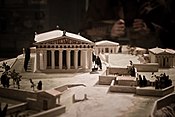
Fifth-century Athens refers to the Greek city-state Athens in period of roughly 480 BCE-404 BCE. This was a period of Athenian political hegemony, economic growth and cultural flourishing known as the Golden Age of Athens or Age of Pericles. The period began in 480 BCE when an Athenian-led coalition of city-states, known as the Delian League, defeated the Persians at Salamis. As the fifth century wore on, what started as an alliance of independent city-states gradually became an Athenian empire. Eventually, Athens abandoned the pretense of parity among its allies and relocated the Delian League treasury from Delos to Athens, where it funded the building of the Athenian Acropolis. With its enemies under its feet and its political fortunes guided by legendary statesman and orator Pericles, Athens as a center of literature, philosophy (see Greek philosophy) and the arts (see Greek theatre). Some of the most important figures of Western cultural and intellectual history lived in Athens during this period: the dramatists Aeschylus, Aristophanes, Euripides and Sophocles, the philosophers Aristotle, Plato and Socrates.
Sparta
Main article: Sparta| Lacedaemon |
|---|
 |
Sparta was a Dorian Greek military state, originally centered in Laconia. As a city-state devoted to military training, Sparta possessed the most formidable army in the Greek world, and after achieving notable victories over the Athenian and Persian Empires, regarded itself as the natural protector of Greece. Laconia or Lacedaemon (Λακεδαίμων) was the name of the wider city-state centered at the city of Sparta, though the name "Sparta" is now used for both.
Following the victories in the Messenian Wars (631 BC), Sparta's reputation as a land-fighting force was unequaled. In 480 BC a small Spartan unit under King Leonidas made a legendary last stand against a massive, invading Persian army at the Battle of Thermopylae. One year later, Sparta assembled at full strength and led a Greek alliance against the Persians at Plataea. There, a decisive Greek victory put an end to the Greco-Persian War along with Persian ambition of expanding into Europe. Even though this war was won by a pan-Greek army, credit was given to Sparta, who besides being the protagonist at Thermopylae and Plataea, had been the nominal leader of the entire Greek expedition.
In later Classical times, Sparta along with Athens, Thebes and Persia had been the main regional powers fighting for supremacy against each other. As a result of the Peloponnesian War, Sparta, a traditionally continental culture, became a naval power. At the peak of her power she subdued many of the key Greek states and even managed to overpower the powerful Athenian navy. By the end of the 5th century she stood out as a state which had defeated at war both the Persian and Athenian Empires, a period which marks the Spartan Hegemony.
Sparta was, above all, a militarist state, and emphasis on military fitness began virtually at birth.
Macedonia
Main article: Macedon| Macedon |
|---|
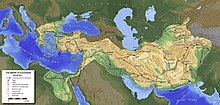 |
Macedon was the name of an ancient kingdom in the northernmost part of ancient Greece, bordering the kingdom of Epirus on the west and the region of Thrace to the east. For a brief period it became the most powerful state in the world after Alexander the Great conquered most of the known world, including the entire Achaemenid Empire, inaugurating the Hellenistic period of Greek history.
The rise of Macedon, from a small kingdom at the periphery of Classical Greek affairs, to one which came to dominate the entire Hellenic world (and beyond), occurred in the space of just 25 years, between 359–336 BC. This ascendancy is largely attributable to the personality and policies of Philip II of Macedon. Philip's military skills and expansionist vision of Macedonian greatness brought him early success. He had however first to re-establish a situation which had been greatly worsened by the defeat against the Illyrians in which King Perdiccas himself had died. The Paionians and the Thracians had sacked and invaded the eastern regions of the country, while the Athenians had landed, at Methoni on the coast, a contingent under a Macedonian pretender called Argeus. Using diplomacy, Philip pushed back Paionians and Thracians promising tributes, and crushed the 3,000 Athenian hoplites (359). Momentarily free from his opponents, he concentrated on strengthening his internal position and, above all, his army. His most important innovation was doubtless the introduction of the phalanx infantry corps, armed with the famous sarissa, an exceedingly long spear, at the time the most important army corps in Macedonia.

Philip's son, Alexander the Great, managed to briefly extend Macedonian power not only over the central Greek city-states, but also to the Persian empire, including Egypt and lands as far east as the fringes of India. Alexander's adoption of the styles of government of the conquered territories was accompanied by the spread of Greek culture and learning through his vast empire. Although the empire fractured into multiple Hellenic regimes shortly after his death, his conquests left a lasting legacy, not least in the new Greek-speaking cities founded across Persia's western territories, heralding the Hellenistic period. In the partition of Alexander's empire among the Diadochi, Macedonia fell to the Antipatrid dynasty, which was overthrown by the Antigonid dynasty after only a few years.
Hellenistic Kingdoms
Main article: Hellenistic civilization
| Hellenistic civilization |
| Antigony · Ptolemy · Seleucidae · Attaly |
Alexander had made no special preparations for his succession in his newly founded empire and the Apocrypha of his death state that on his death-bed he willed it to those that performed actions well and powerfully. The result was the wars of the Diadochi between his generals (the Diadochi, or 'Successors'), which lasted for forty years before a more-or-less stable arrangement was established, consisting of four major domains:
- The Antigonid dynasty in Macedon and central Greece;
- The Ptolemaic dynasty in Egypt based at Alexandria;
- The Seleucid dynasty in Syria and Mesopotamia based at Antioch;
- The Attalid dynasty in Anatolia based at Pergamum.
A further two kingdoms later emerged, the so-called Greco-Bactrian and Indo-Greek kingdom. Hellenistic culture thrived in its preservation of the past. The states of the Hellenistic period were deeply fixated with the past and its seemingly lost glories. Athens retained its position as the most prestigious seat of higher education, especially in the domains of philosophy and rhetoric, with considerable libraries. Alexandria was a center of Greek learning and the Library of Alexandria had 700,000 volumes. The city of Pergamon became a major center of book production, possessing a library of some 200,000 volumes, second only to Alexandria's. The island of Rhodes boasted a famous finishing school for politics and diplomacy. Antioch was founded as a metropolis and center of Greek learning which retained its status into the era of Christianity. Seleucia replaced Babylon as the metropolis of the lower Tigris.
Seleucid Empire
Main article: Seleucid Empire| Seleucid Empire |
|---|
 |
The Seleucid Empire was a Hellenistic empire, and the eastern remnant of the former Achaemenid Persian Empire following its breakup after Alexander the Great's invasion. The Seleucid Empire was centered in the near East. It was a center of Hellenistic culture which maintained the Greek customs and Greek-speaking Macedonian elite.
Seleucid expansion into Greece was abruptly halted after decisive defeats at the hands of the Roman army. Much of the eastern part of the empire was conquered by the Parthians under Mithridates I of Parthia in the mid-2nd century BC, yet the Seleucid kings continued to rule a rump state from Syria until the invasion by Armenian king Tigranes the Great and their ultimate overthrow by the Roman general Pompey.
Ptolemaic Egypt
Main articles: Ptolemaic Egypt and Ptolemaic dynasty| Ptolemaic empire |
|---|
 |
The Ptolemaic dynasty, sometimes also known as the Lagids, was a Greek royal family which ruled the Ptolemaic Empire in Egypt during the Hellenistic period.
Ptolemy, one of the seven somatophylakes (bodyguards) who served as Alexander the Great's generals and deputies, was appointed satrap of Egypt after Alexander's death in 323 BC. In 305 BC, he declared himself King Ptolemy I, later known as "Soter" (saviour). The Egyptians soon accepted the Ptolemies as the successors to the pharaohs of independent Egypt. Ptolemy's family ruled Egypt until the Roman conquest of 30 BC. All the male rulers of the dynasty took the name Ptolemy.
Ptolemaic Egypt began when Ptolemy I Soter declared himself Pharaoh of Egypt in 305 BC and ended with the death of queen Cleopatra VII of Egypt and the Roman conquest in 30 BC. The Ptolemaic Kingdom was a powerful Hellenistic state, extending from southern Syria in the east, to Cyrene to the west, and south to the frontier with Nubia. Alexandria became the capital city and a center of Greek culture and trade. To gain recognition by the native Egyptian populace, they named themselves as the successors to the Pharaohs. The later Ptolemies took on Egyptian traditions, had themselves portrayed on public monuments in Egyptian style and dress, and participated in Egyptian religious life. Hellenistic culture continued to thrive in Egypt well after the Muslim conquest. The Ptolemies faced rebellions of native Egyptians often caused by an unwanted regime and were involved in foreign and civil wars that led to the decline of the kingdom and its annexation by Rome.
Carthage
Main article: Ancient Carthage| Ancient Carthage |
|---|
 |
Carthage was a major power over the Western Mediterranean between 575 BC and 272 BC. Carthage as a major power was originally a Phoenician settlement, and when Tyre fell to the Assyrians, Carthage assumed power over the former settlements of the region. The foundation of Carthaginian power was seafaring trade throughout the Western Mediterranean (following the tracks of the Phoenicians). Some 300 colonies were established in Tunisia, Morocco, Algeria, Iberia, and to a much lesser extent, on the arid coast of Libya. The Phoenicians controlled Cyprus, Sardinia, Corsica, and the Balearic Islands, as well as minor possessions in Crete and Sicily; the latter settlements were in perpetual conflict with the Greeks. The Phoenicians managed to control all of Sicily for a limited time. The entire area later came under the leadership and protection of Carthage, which in turn dispatched its own colonists to found new cities or to reinforce those that declined with Tyre and Sidon.

The first colonies were made on the two paths to Iberia's mineral wealth — along the North African coast and on Sicily, Sardinia and the Balearic Islands. The centre of the Phoenician world was Tyre, serving as an economic and political hub. The power of this city waned following numerous sieges and its eventual destruction by Alexander the Great, and the role as leader passed to Sidon, and eventually to Carthage. Each colony paid tribute to either Tyre or Sidon, but neither had actual control of the colonies. This changed with the rise of Carthage, since the Carthaginians appointed their own magistrates to rule the towns and Carthage retained much direct control over the colonies. This policy resulted in a number of Iberian towns siding with the Romans during the Punic Wars. Although Rome was originally a land based military power, its sphere of influence soon collided with Carthage's. Carthage was in a constant state of struggle with the Roman Republic, which led to a series of conflicts known as the Punic Wars. After the third and final Punic War, Carthage was destroyed and then occupied by Roman forces. Nearly all of the other Phoenician city-states and former Carthaginian dependencies fell into Roman hands from then on.
Ancient India
Main article: History of IndiaAncient India, which consisted of the Indian subcontinent (the modern-day states of India, Pakistan, Nepal, and Bangladesh) was unified under many emperors and governments in history. Ancient texts mention India under the legendary emperor Bharata, these regions roughly form the entities of modern day greater India. Several Indian empires were able to expand across southern Asia, and sometimes into parts of the Middle East, Central Asia and Southeast Asia.
Nanda Empire
Main article: Nanda Empire| Nanda Empire |
|---|
 |
The Nanda Empire originated from Magadha in Ancient India during the 5th and 4th centuries BC. At its greatest extent, the Nandas ruled much of Northern India. The Nandas are sometimes described as the first empire builders in the recorded history of India. They inherited the large kingdom of Magadha. They built up a vast army.
The Nandas never had the opportunity to see their army up against Alexander the Great, who invaded India at the time of Dhana Nanda, since Alexander had to confine his campaign to the plains of Punjab, for his forces, at the prospect of facing a further foe, mutinied at the Hyphasis River (the modern Beas River) refusing to march any further. The Persian and Greek invasions had important repercussions on Indian civilization.
The political systems of the Persians were to influence future forms of governance on the subcontinent, including the administration of the Mauryan dynasty. In addition, the region of Gandhara, or present-day eastern Afghanistan and northwest Pakistan, became a melting pot of Indian, Persian, Central Asian, and Greek cultures and gave rise to a hybrid culture, Greco-Buddhism, which lasted until the 5th century CE and influenced the artistic development of Mahayana Buddhism.
Maurya Empire
Main article: Maurya Empire| Maurya Empire |
|---|
 |
The Mauryan Empire was the first political entity to unite most of the Indian subcontinent and expand into Central Asia and the Middle East. Its soft power further spread into much of Persia and Greece due to its military victories over these regions. Its cultural influence also extended west into Egypt and Syria, and east into Thailand, China and Burma.
The Empire was founded in 322 BC by Chandragupta Maurya. Chandragupta waged a war against the nearby Greek powers and won, forcing the Greeks to surrender large amounts of land. Under the reign of Ashoka the Great, the empire became pacifist and turned to spreading its soft power in the form of Buddhism. It has been estimated that the Maurya Dynasty controlled an unprecedented one-third of the world's entire economy, was home to one-third of the world's population at the time (an estimated 50 million out of 150 million human), contained the world's largest city of the time (Pataliputra, estimated to be larger than Rome under Emperor Trajan).

The Empire was divided into four provinces, which one of the four, look like a giant crescents. with the imperial capital at Pataliputra. From Ashokan edicts, the names of the four provincial capitals are Tosali (in the east), Ujjain in the west, Suvarnagiri (in the south), and Taxila (in the north). The head of the provincial administration was the Kumara (royal prince), who governed the provinces as king's representative. The kumara was assisted by Mahamatyas and council of ministers. This organizational structure was reflected at the imperial level with the Emperor and his Mantriparishad (Council of Ministers).
Historians theorize that the organization of the Empire was in line with the extensive bureaucracy described by Kautilya in the Arthashastra: a sophisticated civil service governed everything from municipal hygiene to international trade. According to Megasthenes, the empire wielded a military of 600,000 infantry, 30,000 cavalry, and 9,000 war elephants. A vast espionage system collected intelligence for both internal and external security purposes. Having renounced offensive warfare and expansionism, Ashoka nevertheless continued to maintain this large army, to protect the Empire and instill stability and peace across West and South Asia.
Sunga Empire
Main article: Sunga Empire| Sunga Empire |
|---|
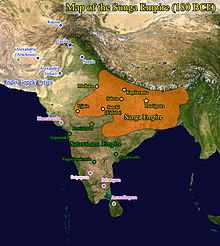 |
The Shunga Empire is a Magadha dynasty that controlled North-central and Eastern India as well as parts of the northwest (now Pakistan) from around 185 to 73 BCE. It was established after the fall of the Indian Maurya Empire. The capital of the Sungas was Pataliputra. Later kings such as Bhagabhadra also held court at Vidisha, modern Besnagar in Eastern Malwa. The Sunga Empire is noted for its numerous wars with both foreign and indigenous powers.
While there is much debate on the religious politics of the Sunga dynasty, it is recognized for a number of contributions. Art, education, philosophy, and other learning flowered during this period. Most notably, Patanjali's Yoga Sutras and Mahabhasya were composed in this period, Panini composed the first Sanskrit grammarian Ashtadayai. It is also noted for its subsequent mention in the Malavikaagnimitra. This work was composed by Kalidasa in the later Gupta period, and romanticized the love of Malavika and King Agnimitra, with a background of court intrigue. Artistry on the subcontinent also progressed with the rise of the Mathura school, which is considered the indigenous counterpart to the more Hellenistic Gandhara school of Afghanistan and Pakistan. During the historical Sunga period (185 to 73 BCE), Buddhist activity also managed to survive somewhat in central India (Madhya Pradesh) as suggested by some architectural expansions that were done at the stupas of Sanchi and Barhut, originally started under Emperor Ashoka. It remains uncertain whether these works were due to the weakness of the control of the Sungas in these areas, or a sign of tolerance on their part.
The last of the Sunga emperor was Devabhuti (83–73 BCE). He was assassinated by his minister (Vasudeva Kanva) and is said to have been overfond of the company of women. The Sunga dynasty was then replaced by the subsequent Kanvas.
Satavahana Empire
Main article: Satavahanas| Satavahanas |
|---|
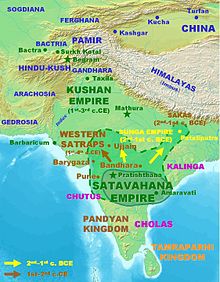 |
The Sâtavâhana Empire started out as feudatories to the Mauryan Empire but declared independence soon after the death of Ashoka (232 BC). They were the first Indic rulers to issue coins struck with their rulers embossed and are known for their patronage of Buddhism resulting in Buddhist monuments from Ellora to Amaravati.
After becoming independent around 230 BCE, Simuka, the founder of the dynasty, conquered Maharashtra, Malwa and part of Madhya Pradesh. He was succeeded by his brother Kanha (or Krishna) (r. 207–189 BCE), who further extended his kingdom to the west and the south. Sātakarnī I was the sixth ruler of the Satavahana. He is said to have ruled for 56 years. Satakarni defeated the Sunga dynasty of North India by wresting Western Malwa from them, and performed several Vedic sacrifices at huge cost, including the Horse Sacrifice – Ashwamedha yajna. He also was in conflict with the Kalinga ruler Kharavela, who mentions him in the Hathigumpha inscription. According to the Yuga Purana he conquered Kalinga following the death of Kharavela. He extended Satavahana rule over Madhya Pradesh and pushed back the Sakas from Pataliputra (he is thought to be the Yuga Purana's "Shata", an abbreviation of the full name “Shri Sata” that occurs on coins from Ujjain), where he subsequently ruled for 10 years. By this time the dynasty was well established, with its capital at Pratishthānapura (Paithan) in Maharashtra, and its power spreading into all of South India.
The Satavahanas formed a cultural bridge and played a vital role in trade and the transfer of ideas and culture to and from the Gangetic plains to the southern tip of India.
Chola Empire
Main article: Chola Empire| Chola Empire |
|---|
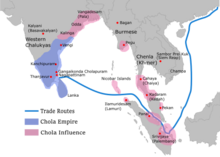 |
The Chola Empire ruled much of India and Southeast Asia. The Tamil dynasty which was one of the longest-ruling dynasties in southern India. The earliest datable references to this Tamil dynasty are in inscriptions from the 3rd century BC left by Asoka, of Maurya Empire; as one of the Three Crowned Kings, the dynasty continued to govern over varying territory until the 13th century AD. By the 9th century, under Rajaraja Chola and his son Rajendra Chola, the Cholas rose as a notable power in south Asia. The Chola Empire stretched as far as Bengal. At its peak, the empire spanned almost 3,600,000 km (1,400,000 sq mi). Rajaraja Chola conquered all of peninsular South India and parts of the Sri Lanka. Rajendra Chola's navies went even further, occupying coasts from Burma (now Myanmar) to Vietnam, the Andaman and Nicobar Islands, Lakshadweep, Sumatra, Java, Malaya in South East Asia and Pegu islands. He defeated Mahipala, the king of the Bengal, and to commemorate his victory he built a new capital and named it Gangaikonda Cholapuram.
The heartland of the Cholas was the fertile valley of the Kaveri River, but they ruled a significantly larger area at the height of their power from the later half of the 9th century till the beginning of the 13th century. The whole country south of the Tungabhadra was united and held as one state for a period of two centuries and more. Under Rajaraja Chola I and his son Rajendra Chola I, the dynasty became a military, economic and cultural power in South Asia and South-east Asia. The power of the new empire was proclaimed to the eastern world by the celebrated expedition to the Ganges which Rajendra Chola I undertook and by the overthrow after an unprecedented naval war of the maritime empire of Srivijaya, as well as by the repeated embassies to China.
During the period 1010–1200, the Chola territories stretched from the islands of the Maldives in the south to as far north as the banks of the Godavari River in Andhra Pradesh. Rajaraja Chola conquered peninsular South India, annexed parts of what is now Sri Lanka and occupied the islands of the Maldives. Rajendra Chola sent a victorious expedition to North India that touched the river Ganges and defeated the Pala ruler of Pataliputra, Mahipala. He also successfully invaded kingdoms of the Malay Archipelago. The Chola dynasty went into decline at the beginning of the 13th century with the rise of the Pandyas, who ultimately caused their downfall.
The Cholas left a lasting legacy. Their patronage of Tamil literature and their zeal in building temples has resulted in some great works of Tamil literature and architecture. The Chola kings were avid builders and envisioned the temples in their kingdoms not only as places of worship but also as centres of economic activity. They pioneered a centralised form of government and established a disciplined bureaucracy.
Gupta Empire
Main article: Gupta Empire See also: Origin of the Gupta dynasty| Gupta Empire |
|---|
 |
In the 4th and 5th centuries, the Gupta Empire unified much of India. This period is called the Golden Age of India and was marked by extensive achievements in science, technology, engineering, art, dialectic, literature, logic, mathematics, astronomy, religion and philosophy that crystallized the elements of what is generally known as Hindu culture. Chandragupta I, Samudragupta, and Chandragupta II were the most notable rulers of the Gupta dynasty.
The high points of this cultural creativity are magnificent architectures, sculptures and paintings. The Gupta period produced scholars such as Kalidasa, Aryabhata, Varahamihira, Vishnu Sharma, and Vatsyayana who made great advancements in many academic fields. Science and political administration reached new heights during the Gupta era. Strong trade ties also made the region an important cultural center and set the region up as a base that would influence nearby kingdoms and regions in Burma, Sri Lanka, Malay Archipelago and Indochina.
Ancient China
Main article: History of ChinaQin Dynasty
Main article: Qin Dynasty| Qin Dynasty |
|---|
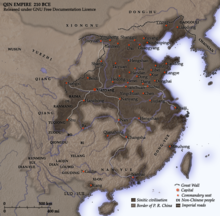 Qin region Outlying regions |
The Qin Dynasty was preceded by the feudal Zhou Dynasty and followed by the Han Dynasty in China. The unification of China in 221 BCE under the First Emperor Qin Shi Huang marked the beginning of Imperial China, a period which lasted until the fall of the Qing Dynasty in 1912.

In 214 BC Qin Shihuang secured his boundaries to the north with a fraction (100,000 men) of his large army, and sent the majority (500,000 men) south to seize still more land. Prior to the events leading to Qin dominance over China, they had gained possession of much of Sichuan to the southwest. The Qin army was unfamiliar with the jungle terrain, and it was defeated by the southern tribes' guerrilla warfare tactics with over 100,000 men lost. However, in the defeat Qin was successful in building a canal to the south, which they used heavily for supplying and reinforcing their troops during their second attack to the south. Building on these gains, the Qin armies conquered the coastal lands surrounding Guangzhou, and took the provinces of Fuzhou and Guilin. They struck as far south as Hanoi. After these victories in the south, Qin Shihuang moved over 100,000 prisoners and exiles to colonize the newly conquered area. In terms of extending the boundaries of his empire, the First Emperor was extremely successful in the south.
Despite its military strength, the Qin Dynasty did not last long. When the first emperor died in 210 BC, his son was placed on the throne by two of the previous emperor's advisers, in an attempt to influence and control the administration of the entire country through him. The advisors squabbled among themselves, however, which resulted in both their deaths and that of the second Qin emperor. Popular revolt broke out a few years later, and the weakened empire soon fell to a Chu lieutenant, who went on to found the Han Dynasty. Despite its rapid end, the Qin Dynasty influenced future Chinese regimes, particularly the Han, and the European name for China is derived from it.
See also: Sinae and Romano-Chinese relationsHan Dynasty
Main article: Han Dynasty| Han Dynasty |
|---|
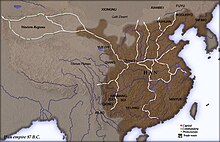 Han region Outlying regions |
The Han Dynasty (206 BC – AD 220), lasting 400 years, is commonly considered within China to be one of the greatest periods in the entire history of China. At its height, the Han empire extended over a vast territory of 6 million km² and housed a population of approximately 55 million. During this time period, China became a military, economic, and cultural powerhouse. The empire extended its political and cultural influence over Korea, Japan, Mongolia, Vietnam, and Central Asia before it finally collapsed under a combination of domestic and external pressures.
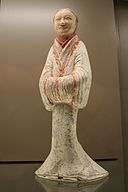
The Han Empire was divided into areas directly controlled by the central government, known as commanderies, and a number of semi-autonomous kingdoms. These kingdoms gradually lost all vestiges of their independence, particularly following the Rebellion of the Seven States. The Xiongnu, a nomadic confederation which dominated the eastern Eurasian Steppe, defeated the Han army in battle in 200 BCE. Following the defeat, a political marriage alliance was negotiated in which the Han became the de facto inferior partner. When, despite the treaty, the Xiongnu continued to raid Han borders, Emperor Wu of Han (r. 141–87 BCE) launched several military campaigns against them. The ultimate Han victory in these wars eventually forced the Xiongnu to accept vassal status as Han tributaries. These campaigns expanded Han sovereignty into the Tarim Basin of Central Asia and helped establish the vast trade network known as the Silk Road, which reached as far as the Mediterranean world. Han forces managed to divide the Xiongnu into two competing nations, the Southern and Northern Xiongnu, and forced the Northern Xiongnu across the Ili River. Despite these victories, the territories north of Han's borders were quickly overrun by the nomadic Xianbei Confederation. The Han Dynasty was arguably one of the strongest's empires in the world during the reign of Emperor Wu, though was established as the largest.
Xiongnu
Main article: Xiongnu| Xiongnu |
|---|
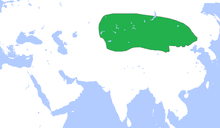 Xiongnu Region Outlying regions |
Xiongnu (Hsiung nu) was an empire flourished in the central Asia. Their origin is debatable, but they probably spoke either a Proto Turkic, or a Proto Mongolic or a Yeniseian language. They conquered most of modern Mongolia under their leader Toumen (220-209 BC) in the 3rd century BC. During Modu‘s reign (209-174 BC) they defeated both the Donghu in the east and Yuezhi in the west and they began threatening Han China.
The Great Wall of China had been constructed to protect Chinese towns from the Xiongnu attacks. While the Chinese were trying to bring the Xiongnu under control, something of high significance happened: cross-cultural encounters. A large variety of people (such as traders, ambassadors, hostages, parents in cross-cultural marriages, etc.) served as helpers that passed on ideas, values, and techniques across cultural boundary lines. These encounters helped cultures learn from other cultures. Xiongnu empire disintegrated into two parts during the 1st century, eventually the Xiongnu fell due to the defeat in the Han–Xiongnu War.
See also: SericaRoman Empire
Main article: Roman Empire| Roman Empire |
|---|
 Roman province (Senatorial and Imperial) Outlying Regions |
The Roman Empire is widely known as ancient Europe's largest and most powerful civilization. After the Punic Wars Rome was already one of the biggest empires on the planet but its expansion continued with the invasions of Greece and Asia Minor. By 27 BC Rome had control over half of Europe as well as Northern Africa and large amounts of the Middle East. Rome also had a developed culture, building on the earlier Greek culture. From the time of Augustus to the Fall of the Western Empire, Rome dominated Western Eurasia, comprising the majority of its population.
Roman expansion began long before the state was changed into an Empire and reached its zenith under emperor Trajan with the conquest of Mesopotamia and Armenia in AD 113. The period of the "Five Good Emperors" saw a successions of peaceful years and the Empire was prosperous. Each emperor of this period was adopted by his predecessor. The Nerva–Antonine dynasty was a dynasty of seven consecutive Roman Emperors who ruled over the Roman Empire from 96 to 192. These Emperors are Nerva, Trajan, Hadrian, Antoninus Pius, Marcus Aurelius, Lucius Verus, and Commodus.
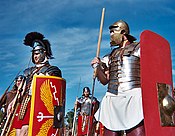
The last two of the "Five Good Emperors" and Commodus are also called Antonines. After his accession, Nerva, who succeeded Domitian, set a new tone: he restored much confiscated property and involved the Roman Senate in his rule. Starting in 101, Trajan undertook two military campaigns against the gold rich Dacia, which he finally conquered in 106 (see Trajan's Dacian Wars). In 112, Trajan marched on Armenia and annexed it to the Roman Empire. Then he turned south into Parthia, taking several cities before declaring Mesopotamia a new province of the empire, and lamenting that he was too old to follow in the steps of Alexander the Great. During his rule, the Roman Empire expanded to its largest extent, and would never again advance so far to the east. Hadrian's reign was marked by a general lack of major military conflicts, but he had to defend the vast territories that Trajan had acquired.
At this territorial peak, the Roman Empire controlled approximately 5,900,000 km² (2,300,000 sq.mi.) of land surface. Ancient Rome's influence upon the culture, law, technology, arts, language, religion, government, military, and architecture of Western civilization continues to this day.
See also: Daqin and Romano-Chinese relationsHunnic Empire
- 370-454
| Hunnic Empire |
|---|
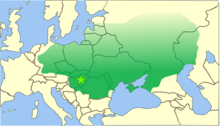 Attila's imperial capital (approximate) Attila's empire (approximate) Non-Hunnic Regions |
Huns were nomadic people who were known for their hordes of mounted archers. Their language seems to be Turkic; but Mongolic, Yeniseian, Uralic etc., are also postulated. After 370 under a certain Balamber they founded an empire in the East Europe defeating Alans and Goths. They triggered the great migration which eventually caused the collapse of the West Roman Empire.
The death of Rugila in 434 left the sons of his brother Mundzuk, Attila and Bleda, in control of the united Hun tribes. Attila the Hun ruled of the Huns from 434 until his death in 453. Under his rule and leader of the Hunnic Empire, the empire stretched from Germany to the Ural River and from the Danube River to the Baltic Sea. Hunnic khagan Atilla invaded Europe. The rise of the Huns around 370 overwhelmed the Gothic kingdoms. Many of the Goths migrated into Roman territory in the Balkans, while others remained north of the Danube under Hunnic rule.
During Attila the Hun's rule, he was one of the most fearsome enemies of the Western and Eastern Roman Empire. He invaded the Balkans twice and marched through Gaul (modern France) as far as Orléans before being defeated at the Battle of Châlons. Although his invasion of Gaul was checked at Chalons, he appeared in North Italy in the next year. After Atilla’s death in 453, the Hunnic empire collapsed.
Medieval Powers
- 476-1492
- Middle Ages
Medieval Middle and Near East
Byzantine Empire
- 330 - 1453
| Byzantine Empire |
|---|
 Western Roman Empire Eastern Byzantine Empire Outlying regions |
The Byzantine Empire is the name for the medieval eastern Roman Empire, which survived 1000 years after the fall of the western Roman Empire. The Byzantines managed to reconquer great parts of it. Ancient Roman cultural heritage survived there and gave birth to the Italian Renaissance after its capital, Constantinople, was captured by the Turks in the 15th century. The Byzantines were the only Europeans to produce fine silk which was an important source of their wealth along with trade.

Byzantium under the Justinian dynasty saw a period of recovery of former territories. The period is marked with internal strife within the Empire, from Ostrogoths, and from the Persians. The strength of the dynasty was shown under Justinian I, in which the territorial borders of the Empire were expanded because of numerous campaigns by his favored general, Belisarius. The western conquests began with Justinian sending his general to reclaim the former province of Africa from the Vandals who had been in control with their capital at Carthage. Their success came with surprising ease, but the major local tribes were subdued. In Ostrogothic Italy, the deaths of Theodoric the Great, his nephew and heir, and his daughter had left her murderer Theodahad on the throne despite his weakened authority. A small Byzantine expedition to Sicily was met with easy success, but the Goths soon stiffened their resistance, and victory did not come until later, when Belisarius captured Ravenna, after successful sieges of Naples and Rome.
Byzantium continued to be a major military power with a huge army and strong fleet, and was a major cultural and religious center. Byzantium was the stronghold of Eastern Orthodox Christianity and thus influenced many states. Byzantium fought against the Arabs to the south, the Bulgarians to the north and the Crusaders, who managed to seize Constantinople in 1204. The Byzantines restored their state in 1261, but its strength never recovered and it was eventually destroyed and replaced by the nascent Ottoman Empire in 1453.
Medieval Turko-Pesian (Iranian) Empires
Uyghur Khaganate
Main article: Uyghur KhaganateThe Uyghur Khaganate established itself as a major power in Central Asia the late 8th century. At their height, they controlled an area of land stretching from the Sea of Okhotsk to the Tibetan Plateau. They built their capital Ordu balik in modern Mongolia. Although they were replaced by their Kyrghyz vassals in 840s, they managed to survive in three smaller states. Those who were called Sari Uyghurs (yellow Uyghur) settled in Gansu (north China). Most Uyghurs settled in Xinjiang (west China). Some Uyghurs together with Karluks ( their former vassals in Transoxania, modern Uzbekistan), founded Karakhanid state which soon embraced Islam.
Great Seljuk empire
- 1040–1154
| Seljuk empire |
|---|
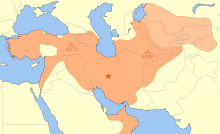 |
The name Seljuk refers to an Oghuz Turkic leader whose tribe had migrated from North (probably Khazar Khanette) to Khorosan where they embraced Islam., Seljuk’s grand sons after defeating Ghaznavids in 1040 founded an empire and decleared themselves to be the protectors of the caliph. Their empire with caliphs prestige, Turkish army and Persian bureaucracy proved to be one of the most powerful of states of 11th century. In 1071 after Alp Arslan of Seljuks defeated Byzantine army at Manzikert, Turks began to settle in Anatolia (Asiatic side of Turkey). But Great Seljuk Empire began to disintegrate in the second half of the 12th century. Soon, they were replaced by a number of states ruled by members of Seljuk house or by atabegs. The most important of these was the Sultanate of Rûm which continued up to 14th century and Khwarezmid Empire in Iran and Turkmenistan which fell prey to Mongols in 1220s.
Arab Caliphates
- 632–1258

| Muslim conquests |
| Muhammad's Expansion (622-632) Patriarchal Expansion (632-661) Umayyad Expansion (661-750) |
In 622, a new world religion emerged, Islam, founded by Muhammad in Arabia. After his death, his successors began a century of rapid Arab expansion across most of the known world, establishing the Islamic Empire as one of the largest in the world.
See also: Muslim historyRashidun Caliphate
Main articles: Rashidun and Rashidun Caliphate
Under the Rashidun Caliphate, the newly united and religiously inspired Muslim Arabs invaded the powerful Sassanid Persian Empire during the Rashidun conquest of Persia and the Byzantine Empire during the Byzantine-Arab Wars. The war of conquest resulted in a complete conquest of the Sassanid Persian Empire and two-thirds of the Byzantine Empire. Within a decade, Rashidun caliphs controlled an empire stretching from the Indus River to the Atlas mountains. Khalid ibn Walid was responsible for most of the conquests on the Byzantine front. After a civil war in 657-661, the almost republic disintegrated and was succeeded by the Ummayad monarchy.
Umayyad Caliphate
Main article: UmayyadThe Umayyad Caliphate completed the Muslim expansion after conquering Roman North Africa, Visigothic Hispania, and a small part of the border of the Indian subcontinent and northwestern China. As a result, the Arab Empire became the largest empire the world had yet seen. However, Umayyad expeditions into the Frankish Kingdom and Byzantium were unsuccessful, as they were eventually stopped by the Bulgarians and Byzantines in 718 and the Franks in 732. Nonetheless, the Caliphate remained a huge military power with a mighty navy.
Abbasid Caliphate
Main articles: Abbasid and Islamic Golden Age| Abbasid Caliphate |
|---|
 |
The period of the Abbasid Caliphate is considered the Golden Age of Islam. The empire was rich with flourishing trade across Asia, Europe and Africa. Its culture was thriving, influenced by the Persians, and boasted great achievements in its economy, arts, architecture, literature, mathematics, philosophy, science, and technology. Many cities grew with large populations, beautiful palaces and gardens such as Baghdad, which had a population of a million at its peak, as well as Damascus, Cairo and Cordoba. The Caliphate eventually diminished in size, and was further reduced during the Crusades. The Caliphate later disintegrated after invasions from the Mongol Empire from the east, ending with the sack of Baghdad in 1258.
Al-Andalus
Main article: Al-Andalus| Caliphate of Córdoba |
|---|
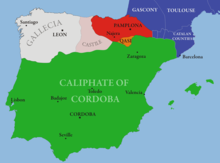 |
Al-Andalus was the Arabic name given to those parts of the Iberian Peninsula governed by Muslims, or Moors, at various times in the period between 711 and 1492. As a political domain or domains, it was successively a province of the Umayyad Caliphate initiated successfully by the Caliph Al-Walid I (711-750), the Emirate of Córdoba (c. 750-929), the Caliphate of Córdoba (929-1031), and finally the Caliphate of Córdoba's taifa (successor) kingdoms.

The Caliphate enjoyed immense prosperity throughout the 10th century. Abd-ar-Rahman III not only united al-Andalus, but brought the Christian kingdoms of the north, through force and diplomacy, under control. Abd-ar-Rahman stopped the Fatimid advance into Caliphate lands in Morocco and al-Andalus. This period of prosperity is marked by growing diplomatic relations with Berber tribes in North African, Christian kings from the north, with France and Germany, and Constantinople. The death of Abd-ar-Rahman III led to the rise of his 46 year old son Al-Hakam II in 961. Al-Hakam II more-or-less followed in his father's footsteps, occasionally dealing with a few disruptive Christian kings and North African rebels, though trying not to be too severe. Unlike his father, al-Hakam's dependence upon his advisers was more distinct.
Fatimid Caliphate
Main article: Fatimid Caliphate| Fatimid Caliphate |
|---|
 |
The al-Fātimiyyūn was the Arab Shi'a dynasty that ruled over varying areas of the Maghreb, Egypt, and the Levant from 5 January 909 to 1171, and established the Egyptian city of Cairo as their capital. The term Fatimite is sometimes used to refer to the citizens of this caliphate. The ruling elite of the state belonged to the Ismaili branch of Shi'ism. The leaders of the dynasty were also Shia Ismaili Imams, hence, they had a religious significance to Ismaili Muslims. They are also part of the chain of holders of the office of Caliph, as recognized by most Muslims. Therefore, this constitutes a rare period in history in which some form of the Shia Imamate and the Caliphate were united to any degree, excepting the Caliphate of Ali himself.

The Fatimids were known to a great extent for their exquisite arts. A type of ceramic, lustreware, was prevalent during the Fatimid period. Glassware and metalworking was also popular. Many traces of Fatimid architecture exist in Cairo today, the most defining examples include the Al Azhar University and the Al Hakim mosque. The Al Azhar University was the first university in the East. It was founded by Caliph Muizz and was one of the highest educational facilities of the Fatimid Empire.
Unlike other governments in the area, Fatimid advancement in state offices was based more on merit than on heredity. Members of other branches of Islam, like the Sunnis, were just as likely to be appointed to government posts as Shiites. Tolerance was extended to non-Muslims such as Christians, and Jews, who occupied high levels in government based on ability.
The reliance on the Iqta' system ate into Fatimid central authority, as more and more the military officers at the further ends of the empire became semi-independent and were often a source of problems.
See also: Emirate of SicilyAyyubid Sultanate
- 1171–1246
| Ayyubid Sultanate |
|---|
 |
The Ayyubid dynasty was a Muslim dynasty of Kurdish origin, founded by Saladin and centered in Egypt. The dynasty ruled much of the Middle East during the 12th and 13th centuries CE. The Ayyubid family, under the brothers Ayyub and Shirkuh, originally served as soldiers for the Zengids until they supplanted them under Saladin, Ayyub's son. The Ayyubid Sultanate in the Middle East managed to rebuild the weakened Arab State. In 1174, Saladin proclaimed himself Sultan following the death of Nur al-Din. The Ayyubids spent the next decade launching conquests throughout the region and by 1183, the territories under their control included Egypt, Syria, northern Mesopotamia, Hejaz, Yemen, and the North African coast up to the borders of modern-day Tunisia. Most of the Kingdom of Jerusalem and beyond Jordan River fell to Saladin after his victory at the Battle of Hattin in 1187. However, the Crusaders regained control of Palestine's coastline in the 1190s.
After the death of Saladin, his sons contested control over the sultanate, but Saladin's brother al-Adil eventually established himself as Sultan in 1200. In the 1230s, the Ayyubid rulers of Syria attempted to assert their independence from Egypt and remained divided until Egyptian Sultan as-Salih Ayyub restored Ayyubid unity by taking over most of Syria, excluding Aleppo, by 1247. During their relatively short tenure, the Ayyubids ushered in an era of economic prosperity in the lands they ruled and the facilities and patronage provided by the Ayyubids led to a resurgence in intellectual activity in the Islamic world. This period was also marked by an Ayyubid process of vigorously strengthening Sunni Muslim dominance in the region by constructing numerous madrasas (schools) in their major cities.
Bahri Mamluks Empire
- 1250–1380
| Mamluk Empire |
|---|
 |
The Bahriyya Mamluks (Bahri dynasty) was a Mamluk dynasty of mostly Kipchak Turkic origin that ruled Egypt, the Levant, and some parts of Iraq, Saudi Arabia and Libya, from 1250 to 1382. Their name means 'of the sea', referring to the location of their original residence on Al-Rodah Island in the Nile (Baḥr an-Nīl) in Cairo at the castle of Al-Rodah which was built by the Ayyubid Sultan as-Salih Ayyub

Under Saladin and the Ayyubids of Egypt, the power of the mamluks increased until they claimed the sultanate in 1250, ruling as the Mamluk Sultanate. Mamluk regiments constituted the backbone of the late Ayyubid military. Each sultan and high-ranking amir had his private corps, and the sultan as-Salih Ayyub (r. 1240-1249) had especially relied on this means to maintaining power. His mamluks, numbering between 800 and 1,000 horsemen, were called the Bahris, after the Arabic word bahr (بحر), meaning sea or large river, because their barracks were located on the island of Rawda in the Nile. They were mostly drawn from among the Kipchak Turks who controlled the steppes north of the Black Sea.
The Bahriyya were succeeded by the Burji dynasty, another group of Mamluks. Tehj Burji saw a turbulent and short-lived Sultanate. Political power-plays often became important in designating a new sultan.
Bulgaria
- 800s - 1000s
| Bulgarian Empire |
|---|
 |
In 681 the Bulgarians established a powerful state which played a major military and cultural role in Medieval Europe. Bulgaria decisively defeated the Arabs in the battle before Constantinople (718) and stopped the Arab invasion in the eastern parts of the continent effectively stopping the migrations of the barbarian tribes (Pechenegs, Magyars, Khazars) further to the west. It destroyed the Avars Khanate in 806.
With the adoption of Christianity and the invention of the Cyrillic Alphabet, the Bulgarian Empire became the cultural and spiritual centre of the whole Slavic world. The Bulgarian Orthodox Church became the first National Church in Europe to gain its independence in 927 with its own Patriarch. The Bulgarian Empire reached its biggest size in the early 10th century stretching from the Black Sea to Bosnia.
The medieval Bulgarian state was restored as the Second Bulgarian Empire after a successful uprising of two nobles from Tarnovo, Asen and Peter, in 1185, and existed until it was conquered during the Ottoman invasion of the Balkans in the late 14th century, with the date of its subjugation usually given as 1396 or 1422. Under Ivan Asen II in the first half of the 13th century it gradually recovered much of its former power, though this did not last long due to internal problems and foreign invasions.
Georgia
- 1184–1225
| Kingdom of Georgia |
|---|
 |
The unified monarchy maintained its precarious independence from the Byzantine and Seljuk empires throughout the 11th century, and flourished under David IV the Builder (1089–1125), who repelled the Seljuk attacks and essentially completed the unification of Georgia with the re-conquest of Tbilisi in 1122.
With the decline of Byzantine power and the dissolution of the Great Seljuk Empire, Georgia became one of the pre-eminent nations of the Christian East, her pan-Caucasian empire stretching, at its largest extent, from North Caucasus to northern Iran, and westwards into Asia Minor. In spite of repeated incidents of dynastic strife, the kingdom continued to prosper during the reigns of Demetrios I (1125–1156), George III (1156–1184), and especially, his daughter Tamar (1184–1213). With the death of George III the main male line went extinct and the dynasty was continued by the marriage of Queen Tamar with the Alan prince David Soslan of reputed Bagratid descent.
Ghaznavid Empire
- 960s - 998
| Ghaznavid Empire |
|---|
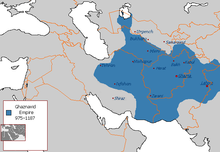 |
The Ghaznavids were a Persianate Muslim dynasty of Turkic mamluk origin which existed from 975 to 1187 and ruled much of Persia, Transoxania, and the northern parts of the Indian subcontinent. The Ghaznavid state was centered in Ghazni, a city in present Afghanistan. Due to the political and cultural influence of their predecessors - that of the Persian Samanid Empire - the originally Turkic Ghaznavids became thoroughly Persianized.
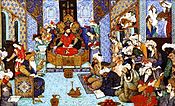
Saboktekin (Mahmud of Ghazni) made himself lord of nearly all the present territory of Afghanistan and of the Punjab by conquest of Samanid and Shahi lands. In 997, Mahmud, the son of Sebük Tigin, succeeded his father upon his death, and with him Ghazni and the Ghaznavid dynasty have become perpetually associated. He completed the conquest of Samanid, Shahi lands, the Ismaili Kingdom of Multan, Sindh as well as some Buwayhid territory. Under him all accounts was the golden age and the height of the Ghaznevid Empire. Mahmud carried out seventeen expeditions through northern India establishing his control and setting up tributary states. His raids also resulted in the looting of a great deal of plunder. From the borders of Kurdistan to Samarkand, from the Caspian Sea to the Yamuna, he established his authority. The wealth brought back from the Indian expeditions to Ghazni was enormous, and contemporary historians (e.g. Abolfazl Beyhaghi, Ferdowsi) give glowing descriptions of the magnificence of the capital, as well as of the conquerors munificent support of literature. Mahmud died in (1030). Even though there was some revival of importance under Ibrahim (1059–1099), the empire never reached anything like the same splendor and power. It was soon overshadowed by the Seljuqs of Iran.
Timurid Empire
- 1370–1526
| Timurid Empire |
|---|
 |
The Timurids were a Persianate Central Asian Sunni Muslim dynasty of originally Turko-Mongol descent whose empire included the whole of Central Asia, Iran, modern Afghanistan, as well as large parts of Pakistan, India, Mesopotamia and Caucasus.
It was founded by the legendary conqueror Timur (Tamerlane) in the 14th century. In the 16th century, Timurid prince Babur, the ruler of Ferghana, invaded North India and founded the Mughal Empire, which ruled most of the North India until its decline after Aurangzeb in the early 18th century, and was formally dissolved by the British Raj after the Indian rebellion of 1857. Later princes of the dynasty predominantly used the title Mirza to show descent from the Amir.
Although the Timurids hailed from the Barlas tribe which was of Turkicized Mongol origin, they had embraced Persian culture, converted to Islam and resided in Turkestan and Khorasan. Thus, the Timurid era had a dual character, which reflected both the Turco-Mongol origins and the Persian literary, artistic, and courtly high culture of the dynasty.
Medieval China and Far East region
The start of the Sui Dynasty in China after the end of the turbulent and chaotic Northern and Southern Dynasty marks China as one of the most powerful countries in the world economically and militarily. Below are some of the dynasties that occurred during this era:
Tang Dynasty
- 630s - 800s
| Tang Dynasty |
|---|
 Taizong (Tang)'s conquest in Asia in succession: Shanxi (617 : his father is governor, Taizong support his revolt.) Sui Empire Protector (618). Tang dynasty established (618). Controlled all of Sui China by 622-626. Submission of the Oriental Turks' territories (630-682) Tibet's King recognizes him as their emperor (641-670) Submission of the Occidental Turks' territories (642-665) (idem) added the Oasis (640-648 : northern Oasis ; 648 : southern Oasis) |
The Tang Dynasty was an imperial dynasty of China preceded by the Sui Dynasty and followed by the Five Dynasties and Ten Kingdoms Period. It was founded by the Li (李) family, who seized power during the decline and collapse of the Sui Empire. The dynasty was interrupted briefly by the Second Zhou Dynasty (October 16, 690–March 3, 705) when Empress Wu Zetian seized the throne, becoming the only Chinese empress regnant, ruling in her own right.

The Tang Dynasty, with its capital at Chang'an, the most populous city in the world at the time, is generally regarded as a high point in Chinese civilization—equal to, or surpassing that of, the earlier Han Dynasty—a golden age of cosmopolitan culture. Its territory, acquired through the military campaigns of its early rulers, was greater than that of the Han period, and it rivalled that of the later Yuan Dynasty and Qing Dynasty. In two censuses of the 7th and 8th centuries, the Tang records estimated the population by number of registered households at about 50 million people. Yet, even when the central government was breaking down and unable to compile an accurate census of the population in the 9th century, it is estimated that the population had grown by then to about 80 million people. With its large population base, the dynasty was able to raise professional and conscripted armies of hundreds of thousands of troops to contend with nomadic powers in dominating Inner Asia and the lucrative trade routes along the Silk Road.
Various kingdoms and states paid tribute to the Tang court, while the Tang also conquered or subdued several regions which it indirectly controlled through a protectorate system. Besides political hegemony, the Tang also exerted a powerful cultural influence over neighboring states such as those in Korea, Japan, and Vietnam. Such was the dynasty's influence that even today, the Chinese term for a Chinatown bears the title, the Tang People's Street.
The Tang Dynasty was largely a period of progress and stability, except during the An Shi Rebellion and the decline of central authority in the latter half of the dynasty. Like the previous Sui Dynasty, the Tang Dynasty maintained a civil service system by drafting officials through standardized examinations and recommendations to office. This civil order was undermined by the rise of regional military governors known as jiedushi during the 9th century. Chinese culture flourished and further matured during the Tang era; it is considered the greatest age for Chinese poetry. Two of China's most famous poets, Du Fu and Li Bai, belonged to this age, as did many famous painters such as Han Gan, Zhang Xuan, and Zhou Fang. There was a rich variety of historical literature compiled by scholars, as well as encyclopedias and geographical works.
There were many notable innovations during the Tang, including the development of woodblock printing. Buddhism became a major influence in Chinese culture, with native Chinese sects gaining prominence. However, Buddhism would later be persecuted by the state and decline in influence. Although the dynasty and central government were in decline by the 9th century, art and culture continued to flourish. The weakened central government largely withdrew from managing the economy, though the country's mercantile affairs stayed intact and commercial trade continued to thrive regardless.
Song Dynasty
- 990s - 1080s
| Song Dynasty |
|---|
 Song region Liao region Xi Xia region Outlying regions |

During the Song Dynasty, the wealth of China attracted numerous attacks from the north and the dynasty gradually retreated to the south. For the first time in history, China needed to pay tribute annually to buy peace. Ironically, the development of Chinese culture reached the highest peak in history due to the artistic character of the emperors. The technological advancement and policies also led to rapid growth of wealth and improvement of living standard.
The Song Dynasty is divided into two distinct periods: the Northern Song and Southern Song. During the Northern Song (Chinese: 北宋, 960–1127), the Song capital was in the northern city of Bianjing (now Kaifeng) and the dynasty controlled most of inner China. The Southern Song (Chinese: 南宋, 1127–1279) refers to the period after the Song lost control of northern China to the Jin Dynasty. During this time, the Song court retreated south of the Yangtze River and established their capital at Lin'an (now Hangzhou). Although the Song Dynasty had lost control of the traditional birthplace of Chinese civilization along the Yellow River, the Song economy was not in ruins, as the Southern Song Empire contained 60 percent of China's population and a majority of the most productive agricultural land. The Southern Song Dynasty considerably bolstered its naval strength to defend its waters and land borders and to conduct maritime missions abroad.
To repel the Jin, and later the Mongols, the Song developed revolutionary new military technology augmented by the use of gunpowder. In 1234, the Jin Dynasty was conquered by the Mongols, who took control of northern China, maintaining uneasy relations with the Southern Song. Möngke Khan, the fourth Great Khan of the Mongol Empire, died in 1259 while besieging a city in Chongqing. His younger brother Kublai Khan was proclaimed the new Great Khan, though his claim was only partially recognized by the Mongols in the west. In 1271, Kublai Khan was proclaimed the Emperor of China. After two decades of sporadic warfare, Kublai Khan's armies conquered the Song Dynasty in 1279. China was once again unified, under the Yuan Dynasty (1271–1368).
The population of China doubled in size during the 10th and 11th centuries. This growth came through expanded rice cultivation in central and southern China, the use of early-ripening rice from southeast and southern Asia, and the production of abundant food surpluses. The Northern Song census recorded a population of roughly 50 million, much like the Han and Tang dynasties.
See also: Society of the Song DynastyMongol Empire
- 1206 - 1370s
| Mongol Empire |
|---|
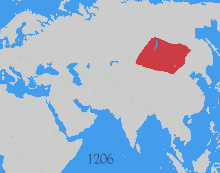 |
The Mongol Empire was an empire from the 13th and 14th century spanning from Eastern Europe across Asia. It is the largest contiguous empire in the history of the world. It emerged from the unification of Mongol and Turkic tribes in modern day Mongolia, and grew through invasions, after Genghis Khan had been proclaimed ruler of all Mongols in 1206. At its greatest extent it stretched from the Danube to the Sea of Japan and from northern Siberia to Camboja, covering over 24,000,000 km (9,300,000 sq mi), 22% of the Earth's total land area, and held sway over a population of over 100 million people. It is often identified as the "Mongol World Empire" because it spanned much of Eurasia. As a result of the empire's conquests and political and economic impact on most of the Old World, its wars with other great powers in Africa, Asia and Europe are also believed to be an ancient world war. Under the Mongols new technologies, various commodities and ideologies were disseminated and exchanged across Eurasia.
However, the empire began to split following the succession war in 1260-1264, with the Golden Horde and the Chagatai Khanate being de facto independent and refusing to accept Kublai Khan as Khagan. By the time of Kublai Khan's death, the Mongol Empire had already fractured into four separate khanates or empires, each pursuing its own separate interests and objectives: the Golden Horde in Russia, the Chagatai Khanate in Central Asia, the Ilkhanate in Persia and the Yuan dynasty in China. The Mongol rulers of Central Asia successfully resisted Kublai's attempt to reduce the Chagatayid and Ogedeid families to obedience. It was not until 1304, when the Yuan Dynasty re-established nominal suzerainty over the western khanates. However, with the breakup of the Yuan Dynasty in 1368, the Mongol Empire finally dissolved.
See also: Golden Horde, Chagatai Khan, and IlkhanateYuan Dynasty
- 1271–1368
| Yuan Dynasty |
|---|
 |
The Yuan Dynasty lasting from 1271 to 1368. The dynasty was established by ethnic Mongols, and it had nominal control over the entire Mongol Empire (stretching from Eastern Europe to the fertile crescent to Russia); however, the Mongol rulers in Asia were only interested in China. Later successors did not even attempt to stake claim over the Khakhan title and saw themselves as Emperor of China, as the Yuan Dynasty grew from being an Imperial Mongol administration under Kublai Khan to becoming a basically Chinese institution under his successors.
In according to the Chinese historians, the Mongolian Yuan Dynasty followed the Song Dynasty and preceded the Ming Dynasty in the historiography of China. A rich cultural diversity developed during the Yuan Dynasty. The major cultural achievements were the development of drama and the novel and the increased use of the written vernacular. The political unity of China and much of central Asia promoted trade between East and West. The Mongols' extensive West Asian and European contacts produced a fair amount of cultural exchange. The other cultures and peoples in the Mongol World Empire permanently influenced China. Tibetan-rite Tantric Buddhism also had a significant impact in Chinese Buddhism during that period. The Muslims of the Yuan Dynasty introduced Middle Eastern cartography, astronomy, medicine, clothing, and diet in East Asia. Middle Eastern crops such as carrots, turnips, new varieties of lemons, eggplants, and melons, high-quality granulated sugar, and cotton were all either introduced or successfully popularized by the Yuan Mongols.
The Yuan undertook extensive public works. Road and water communications were reorganized and improved. To provide against possible famines, granaries were ordered built throughout the empire. The city of Beijing was rebuilt with new palace grounds that included artificial lakes, hills and mountains, and parks. During the Yuan period, Beijing became the terminus of the Grand Canal of China, which was completely renovated. These commercially oriented improvements encouraged overland and maritime commerce throughout Asia and facilitated direct Chinese contacts with Europe. Chinese travelers to the West were able to provide assistance in such areas as hydraulic engineering. Contacts with the West also brought the introduction to China of a major food crop, sorghum, along with other foreign food products and methods of preparation.
In historiography of Mongolia, the Yuan Dynasty is generally considered to be the continuation of the Mongol Empire. In traditional historiography of China on the other hand, the Yuan Dynasty is usually considered to be the legitimate dynasty between the Song Dynasty and the Ming Dynasty. Note, however, Yuan Dynasty is traditionally often extended to cover the Mongol Empire before Kublai Khan's formal establishment of the Yuan in 1271, partly because Kublai had his grandfather Genghis Khan placed on the official record as the founder of the dynasty or Taizu. Despite the traditional historiography as well as the official views (including the government of the Ming Dynasty which overthrew the Yuan Dynasty), there also exist Chinese people who did not consider Yuan Dynasty as a legitimate dynasty of China, but a period of foreign domination. The latter believe that Han Chinese were treated as second-class citizens, and China stagnated economically and scientifically; in addition, Chinese technologies such as gunpowder and the compass spread to Europe under the Yuan.
Ming Dynasty
- 1370s - 1550s
| Ming Dynasty |
|---|
 |
The Ming Dynasty (Empire of the Great Ming), was the ruling dynasty of China from 1368 to 1644, following the collapse of the Mongol-led Yuan Dynasty. The Ming, "one of the greatest eras of orderly government and social stability in human history", was the last dynasty in China ruled by ethnic Hans. Although the Ming capital Beijing fell in 1644 to a rebellion led by Li Zicheng who established the Shun Dynasty, which was soon replaced by the Manchu-led Qing Dynasty, regimes loyal to the Ming throne (collectively called the Southern Ming Dynasty) survived until 1662.
Ming rule saw the construction of a navy and a standing army. Although private maritime trade and official tribute missions from China had taken place in previous dynasties, the tributary fleet under the Muslim eunuch admiral Zheng He in the 15th century. There were enormous construction projects, including the restoration of the Grand Canal and the Great Wall and the establishment of the Forbidden City in Beijing during the first quarter of the 15th century. Estimates for the late-Ming population vary from 160 to 200 million. The Ming dynasty is often regarded as both a high point in Chinese civilization as well as a dynasty in which early signs of capitalism emerged.
Emperor Hongwu attempted to create a society of self-sufficient rural communities in a rigid, immobile system that would have no need to engage with the commercial life and trade of urban centers. His rebuilding of China's agricultural base and strengthening of communication routes through the militarized courier system had the unintended effect of creating a vast agricultural surplus that could be sold at burgeoning markets located along courier routes. Rural culture and commerce became influenced by urban trends. The upper echelons of society embodied in the scholarly gentry class were also affected by this new consumption-based culture. In a departure from tradition, merchant families began to produce examination candidates to become scholar-officials and adopted cultural traits and practices typical of the gentry. Parallel to this trend involving social class and commercial consumption were changes in social and political philosophy, bureaucracy and governmental institutions, and even arts and literature
See also: Economy of the Ming Dynasty and List of tributaries of Imperial ChinaMedieval Europe
Frankish Empire
- 790s - 840s
| Frankish Empire |
|---|
 |
The Merovingian dynasty founded one of the monarchies which replaced the Western Roman Empire from the fifth century. The Frankish state consolidated its hold over large parts of western Europe by the end of the eighth century, developing into the Carolingian Empire which dominated most of Western Europe. This empire would gradually evolve into France and the Holy Roman Empire. Under the nearly continuous campaigns of Charles Martel, Pepin the Short, and Charlemagne —father, son, grandson — the greatest expansion of the Frankish empire was secured by the early 9th century. The tradition of dividing patrimonies among brothers meant that the Frankish realm was ruled, nominally, as one polity subdivided into several regna (kingdoms or subkingdoms).
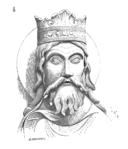
The Franks were united for the first time by Clovis I in the late 5th century. The geography and number of subkingdoms varied over time, but the particular term Francia came generally to refer to just one regnum, that of Austrasia, centred on the Rhine and Meuse rivers in northern Europe; even so, sometimes the term was used as well to encompass Neustria north of the Loire and west of the Seine. Eventually, the singular use of the name Francia shifted towards Paris, and settled on the region of the Seine basin surrounding Paris, which still today bears the name Île-de-France, and which region gave its name to the entire Kingdom of France. In 732 the Franks managed to defeat the Arabs at Poitiers, thereby halting their invasion of Western Europe.

During the reign of Charlemagne, it reached its greatest extent, encompassing most of the territory of the Western Roman Empire, and eventually he was proclaimed Emperor by the Pope in 800. He Christianised the pagan peoples he defeated. This was a period of cultural revival known as the Carolingian Renaissance with important educational and writing reforms. On Christmas Day, 800, Pope Leo III crowned Charles as "Emperor of the Romans" in Rome in a ceremony presented as a surprise (Charlemagne did not wish to be indebted to the bishop of Rome), a further papal move in the series of symbolic gestures that had been defining the mutual roles of papal auctoritas and imperial potestas. Though Charlemagne, in deference to Byzantine outrage, preferred the title "Emperor, king of the Franks and Lombards", the ceremony formally acknowledged the Frankish Empire as the successor of the (Western) Roman one (although only the forged "Donation" gave the pope political authority to do this), thus triggering a series of disputes with the Byzantines around the Roman name. After an initial protest at the usurpation, in 812, the Byzantine Emperor Michael I Rhangabes acknowledged Charlemagne as co-Emperor. The coronation gave permanent legitimacy to Carolingian primacy among the Franks. The Ottonians later resurrected this connection in 962. The empire disintegrated into three parts after the death of his son Louis the Pious, from which later emerged France and Germany.
Kingdom of Germany and after
Main articles: Kingdom of Germany and Holy Roman Empire| The Holy Roman Empire | ||
|---|---|---|
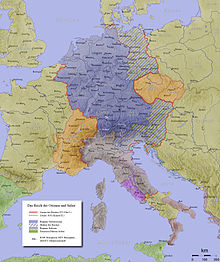 Imperial region Borders (Solid); Otto I (927) Borders (Dots); Konrad II (1032) Theodisc kingdom (Solid) Saxon Eastern March (Slashed) Kingdom of Italy Burgundy / Bohemia / Moravia Other regions
| ||
The Kingdom of Germany grew out of East Francia in the 10th century. The eastern partition of the Treaty of Verdun of 843, or East Francia, encompassed a population that was never entirely Frankish, but also included large numbers of Saxons, Bavarii, Thuringii, Alemanni and Frisii. When the crown passed to a non-Frankish dynasty (the Liudolfings), the term regnum Teutonicum or Teutonicorum came into informal use. By the High Middle Ages, the German character of the united stem duchies was generally recognised.
As the other various states removed themselves from its orbit, leaving solely Germany, her kings holding the imperial title and struggling for it, the German state became synonymous with the Empire and in the time of the Renaissance, the "Holy Roman Empire of the German Nation" united the two concepts of empire and kingdom. Although the term "sacrum" (i.e. "holy") in connection with the medieval Roman Empire did not appear until 1157 under Frederick I Barbarossa, it is Otto I (also known as Otto the Great and Otto the German), crowned King of Germany in 962, who is generally considered to have been the first Holy Roman Emperor. Otto was the first emperor of the realm that later became known as the Holy Roman Empire who was not a member of the earlier Carolingian dynasty. The last Holy Roman Emperor was Francis II, who abdicated and dissolved the Empire in 1806 during the Napoleonic Wars. In a decree following the 1512 Diet of Cologne, the name was officially changed to Holy Roman Empire of the German Nation.
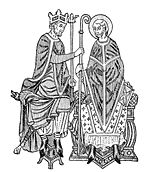
The term rex teutonicorum (king of the Germans) first came into use in the chancery of Pope Gregory VII during the Investiture Controversy (late 11th century), perhaps as a polemical tool against the Emperor Henry IV. In the twelfth century, in order to stress the imperial and transnational character of their office, the emperors began to employ the title rex Romanorum (king of the Romans) on their election (by the prince-electors, seven German bishops and noblemen). Distinct titulature for Germany, Italy and Burgundy, which traditionally had their own courts, laws, and chanceries, gradually dropped from use. After the Reichsreform and Reformation settlement, the German part of the Holy Roman Empire was divided into Reichskreise (imperial circles), which effectively defined Germany against imperial Italy and the Kingdom of Bohemia. The archepiscopal electors continued to bear the titles of chancellors of Germany, Italy and Burgundy. After the Peace of Westphalia (1648), Germany was effectively a congeries of independent states and statelets, over which the remaining institutions of Kingdom and Empire claimed a declining authority. The German kingdom survived until the abdication of Francis II in 1806.
Medieval Kingdom of Hungary
- 1000-1526
| Magyar tribes |
|---|
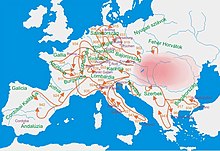 Magyar region Most European nations were praying for mercy: "Sagittis hungarorum libera nos Domine" - "Lord save us from the arrows of Hungarians" |
The origin of the system of the tribes among the Magyars has not been discovered yet, but the distribution into seven tribes had been established by the middle of the 9th century. The seven tribes (Jenő, Kér, Keszi, Kürt-Gyarmat, Megyer, Nyék and Tarján) formed a confederation called "Hétmagyar" (ie, "The Seven Magyars"). Their leaders, who besides Álmos included Előd, Ond, Kond, Tas, Huba and Töhötöm, took a blood oath, swearing eternal loyalty to Álmos. The confederation of the tribes was probably led by two high princes: the kende (their spiritual ruler) and the gyula (their military leader). The high princes were either elected by the leaders of the tribes or appointed by the Khagan of the Khazars who had been exerting influence over the Magyars.

The Kingdom of Hungary in the Middle Ages, after its sedentarization and conversion to Christianity, became a European power and served as the "gate to Europe" from Asia. A "kingdom" arose only in AD 1000 and a Hungarian state or principality only in the late 9th century, but the concept describes its early development after the year 896 when the Magyars arrived in the Carpathian Basin. The Hungarian kingdom's golden age was during the reign of Matthias Corvinus, the son of John Hunyadi. His nickname was "Matthias the Just". He further improved the Hungarian economy and practised astute diplomacy in place of military action whenever possible. Matthias did undertake campaigning when necessary. In 1485, aiming to limit the influence and meddling of the Holy Roman Empire in Hungary's affairs, he occupied Vienna for 5 years. After his death, Vladislaus II of Hungary of the Jagiellonians was placed on the Hungarian throne.
Jagiellon dynasty
- 1386–1572

The Jagiellonian dynasty (Template:Lang-pl, Template:Lang-lt) was a royal dynasty originating from the Lithuanian House of Gediminas. 14 August 1385 by Jogaila, Grand Duke of Lithuania, in exchange for marriage to the underage reigning Queen Jadwiga of Poland.Jogaila converted to Christianity, married Jadwiga, and was crowned King of Poland in 1386. Jagiellonian dynasty that reigned in Central European countries (present day Lithuania, Belarus, Poland, Ukraine, Latvia, Estonia, parts of Russia (including nowadays Kaliningrad oblast), Hungary, Czech Republic, Slovakia) between the 14th and 16th century. Members of the dynasty were Grand Dukes of Lithuania (1377–1392 and 1440–1572), kings of Poland (1386–1572), kings of Hungary (1440–1444 and 1490–1526), and kings of Bohemia (1471–1526).
The dynastic union between the two countries (converted into a full administrative union only in 1569) is the reason for the common appellation "Poland–Lithuania" in discussions about the area from the Late Middle Ages onwards. One Jagiellonian briefly ruled both Poland and Hungary (1440–44), and two others ruled both Bohemia (from 1490) and Hungary (1490–1526) and then continued in the distaff line as the Eastern branch of the House of Habsburg.
See also: Polish–Lithuanian Commonwealth and History of Poland during the Jagiellon dynastyNorman Empire
- 1017–1154
| Normans |
|---|
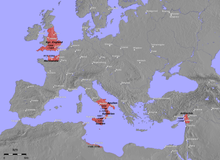 |
The Normans were the people who gave their names to Normandy, a region in northern France. They descended from Viking conquerors of the territory and the native population of mostly Frankish and Gallo-Roman stock. Their identity emerged initially in the first half of the 10th century, and gradually evolved over succeeding centuries until they disappeared as an ethnic group in the early 13th century. The name "Normans" derives from "Northmen" or "Norsemen", after the Vikings from Scandinavia who founded Normandy (Northmannia in its original Latin).

They played a major political, military, and cultural role in medieval Europe and even the Near East. They were famed for their martial spirit and Christian piety. They quickly adopted the Romance language of the land they settled in, their dialect becoming known as Norman, an important literary language. The Duchy of Normandy, which they formed by treaty with the French crown, was one of the great large fiefs of medieval France. The Normans are famed both for their culture, such as their unique Romanesque architecture, and their musical traditions, as well as for the military accomplishments and innovations. Norman adventurers established a kingdom in Sicily and southern Italy by conquest, and a Norman expedition on behalf of their duke led to the Norman Conquest of England. Norman influence spread from these new centres to the Crusader States in the Near East, to Scotland and Wales in Great Britain, and to Ireland.
Papacy
- 756 - 1870
The history of the Roman Catholic Church from apostolic times covers a period of nearly two thousand years, making it the world's oldest and largest institution. The office of the Pope, as the chief of Catholic Church is called the Papacy; the ecclesiastical jurisdiction of the Pope is called the Holy See or Apostolic See. During the Middle Ages the spiritual and civil authority of the Popes was far more extended over Europe, than the relatively small territories under their direct rule, the Papal States, that were the base of their power, in fact many kingdoms were vassals of the Holy See and the Popes were directly involved in the choosing of many rulers, especially the Holy Roman Emperors. Usually the Popes were also involved as primary judges and counselors in all the questions of marriage and succession regarding many kings.
Particularly during the Late Middle Ages the Papacy played a major temporal role in addition to its spiritual role. The conflict between the Pope and the Holy Roman Emperor was fundamentally a dispute over which of them was the leader of Christendom in secular matters. The success of the early crusades added greatly to the prestige of the Popes as secular leaders of Christendom, with monarchs like the Kings of England, France, and even the Emperor merely acting as Marshals for the popes and leading "their" armies. The apogee of the Popes was signed by the reign of Innocent III, when the papacy was at the height of its powers and Innocent III was considered to be the most powerful person in Europe at the time.
The Papal States comprised those territories over which the Pope was a direct ruler in a civil as well as a spiritual sense, before 1870. The plural Papal States is usually preferred; the singular Papal State is rather used for the modern State of Vatican City, created by the Lateran Treaty of 1929. The ancient Papal States were formed around Rome in central Italy in the today regions of Lazio, Umbria, Marche and Emilia-Romagna, but also in a little portion of Provence (actual France) around the city of Avignon.
See also: History of the Roman Catholic ChurchKingdom of Sicily
- 1059–1250

With Robert Guiscard the Norman armies (see Norman conquest of southern Italy) became the main power in the central-west Mediterranean, influencing the policy of the Popes and the Holy Roman Emperors. Successively under the rule of his descendants, the Norman Kings Roger II, William I, William II the Kingdom of Sicily dominated with his fleet, army and trade the regions of south Europe and north Africa for more than two centuries. In the same time some of the sons and nephews of Robert, participated at the First Crusade and conquered the Principality of Antioch and the County of Edessa.

The apogee of the Kingdom of Sicily was under the rule of Holy Roman Emperor Frederick II, who inherited it by his mother, Constance of Sicily. Frederick II used the powerful Kingdom of Sicily as a solid base for his imperial policy, in fact the Norman kings had created one of the first relatively modern bureaucracy and so at that time, Sicily was one of the first well ruled states in Europe, the kingdom also had a very flourishing agriculture and was at the center of the Mediterranean trade.
The decline of Sicily started in 1266, when the last son of Frederick, Manfred of Sicily, died in the Battle of Benevento: the Kingdom was initially conquered by Charles, Count of Anjou and Provence and some years later, in 1282, it was divided in two halves during the so-called Sicilian Vespers.
See also: Norman-Arab-Byzantine cultureRepublic of Genoa
- 1099–1380
| Republic of Genoa |
|---|
 |
The Republic of Genoa was a state originating from the city of Genoa, and existed from 1005 to 1797. During the high Middle Ages the Republic of Genoa was able to become a very wealthy and powerful state through the rich trade between Europe and the Mediterranean sea, becoming one of the early model of capitalistic empires. Genoa started her main expansion expelling the Arab pirates from the Tyrrhenian Sea and west Mediterranean; in 1099 Genoa participated at the Crusades directly or more often supplying the armies, and so the city gained many settlements and commercial bases in the Levant. The apogee of Genoa was during the 13th century when her fleet dominated the western Mediterranean trade and in the same time the city was able to match the power of the rival Republic of Venice in the East. The Battle of Chioggia (1380) started the decline of Genoa.
See also: Maritime republics and Republic of PisaMedieval Venetian Republic
- 1204–1489
| Venetian Republic |
|---|
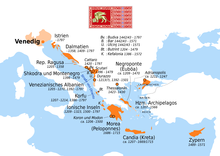 |
The Republic of Venice was a state originating from the city of Venice, and existed for a millennium from the late 7th century (697) until the year 1797 when the Austrians took its possessions. The leader of Venetian Republic was called a Doge. Doges of Venice were elected for life by the Republic's aristocracy.
In the Medieval times Venice was able to become the main trade center between Europe and the East, and also one of the most rich cities in the world. During the Fourth Crusade (1204) the Franco-Venetian force conquered the Byzantine Empire and 1/4 of it was granted to Venice, especially some important isles (as Candia) and commercial bases around the Aegean Sea and Black Sea. In the successive centuries the Republic was able to consolidate her position, against powerful rivals as the Republic of Genoa, meanwhile dominating with her fleet the Adriatic Sea and East Mediterranean. During the 13th and 14th centuries Venice, participating in the Italians wars, was also able to conquest a more land based dominion (the so-called Domini di Terraferma). The conquest of the Kingdom of Cyprus in 1489 signed the end of the expanding period of Venice.
See also: Maritime republics and Lombard LeagueCapetian Kingdom of France
- 987–1453

The Capetian dynasty in France started in 987 with the accession to the throne of Hugh Capet, Duke of France and Count of Paris. During three centuries the Capetian Kings were able to extend their direct rule from the small area around Paris to the majority of France, absorbing to the crown many almost independent fiefs.
Particular strong was the competition against the Plantagenet dynasty that ruled contemporaneously over England and many fiefs in north and central-south France (Normandie, Brittany, Anjou, Poitou, Aquitaine). But finally the King of France Philip II Augustus was able to conquer 2⁄3 of the Plantaginian territories.
Angevin Empire
- 1154–1453
| Angevin Empire |
|---|
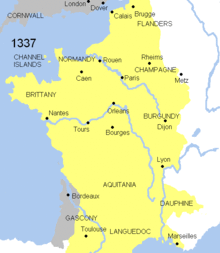 |
The Angevin Empire was a collection of states ruled by the Plantagenet dynasty. The Plantagenets ruled over the Kingdom of England, the Duchy of Normandy, the Duchy of Aquitaine, the Duchy of Gascony and various French counties (constituting approximately half of the then kingdom of France), the Lordship of Ireland, and the Kingdom of Jerusalem. Their empire in France stretched from the Pyrenees to the English Channel over the 12th to the 15th century.

The empire started when Plantegenet Henry II was made King of England. Successive Plantegenet kings of England possessed large areas of territory in France throughout much of the middle ages. Although England was the main source of revenue, the strategic situation meant the early Plantagenets usually ruled their empire from France, notably from Poitiers, the capital of Aquitaine, which was the birthplace of the dynasty, and they were buried in the Fontevraud Abbey near Poitiers. Starting with John Lackland the centre of political activity shifted to England due to the loss of most of their continental territories.
The end of the empire began when the Plantagenets were defeated by the king of France, Philip II Augustus, of the House of Capet, which left their empire split in two, losing the provinces Normandy and Anjou. This defeat, which left the ruling Plantagenets with their English territories and Gascony in France, set the scene for the Hundred Years' War, which started when the Plantagenet kings, provoked by French aggression against their trading partners in the Low Countries, proclaimed themselves rightful kings of France. The war lasted 116 years and the rival Valois claimants eventually conquered the majority of France, except for enclaves such as Calais, which ended the empire.
See also: Hundred Years' WarKingdoms of Aragon
- 1340s - 1480s
| Crown of Aragon |
|---|
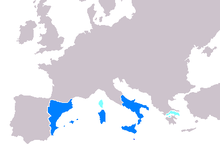 |
The Crown of Aragon was a Maritime Empire in the late Middle Ages that controlled a large portion of present-day northeastern Spain and southeastern Italy, as well as possessions stretching across the Mediterranean Sea as far as Greece. It originated in 1137, when the Kingdom of Aragon and the possessions of the County of Barcelona merged by dynastic union into what later would be known as the Crown of Aragon.
In 1479 a new dynastic union merged the Crown of Aragon with the Crown of Castile, thus making the dawn of the Spanish Empire. Ferdinand married Infanta Isabella of Castile, half-sister of King Henry IV of Castile, who became Queen of Castile and Léon after his death in 1474. Their marriage was a dynastic union which became the constituent event for the dawn of the Kingdom of Spain. At that point both Castile and the Crown of Aragon remained distinct territories, each keeping its own traditional institutions, parliaments and laws.
The process of territorial consolidation was completed when King Charles I, becoming known as Charles V, in 1516 united all the kingdoms on the Iberian peninsula minus Portugal under one monarch (his co-monarch and mother Queen Joanna I in confinement), thereby furthering the creation of the Spanish state, albeit a decentralized one. The Crown of Aragon lasted through 1716, when it was abolished by the Nueva Planta decrees as a result of the Aragonese defeat in the War of the Spanish Succession.
See also: Compromise of CaspeKingdom of Castile
- 1230–1480
| Kingdom of Castile |
|---|
 |
The Kingdom of Castile was one of the medieval kingdoms of the Iberian Peninsula. It was created as a politically autonomous entity in the 9th century: it was called County of Castile and was held in vassalage from the Kingdom of León, which was later incorporated. Its name is supposed to be related to the host of castles constructed in the region. It was one of the ancestor kingdoms of the Kingdom of Spain.
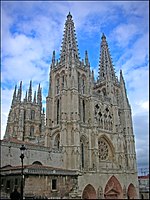
As with all medieval kingdoms, supreme power was understood to reside in the monarch "by the grace of God," as the legal formula explained. Nevertheless, rural and urban communities began to form assemblies to issue regulations to deal with everyday problems. Over time, these assemblies evolved into municipal councils, known as variously as ayuntamientos or cabildos, in which some of the inhabitants, the property-owning heads of households (vecinos), represented the rest.
By the fourteenth century these councils had gained more powers, such as the right to elect municipal magistrates and officers (alcaldes, speakers, clerks, etc.) and representatives to the parliaments (Cortes). Due to the increasing power of the municipal councils and the need for communication between these and the King, cortes were established in the Kingdom of León in 1188, and in Castile in 1250. In the earliest Leonese and Castilian Cortes, the inhabitants of the cities (known as "laboratores") formed a small group of the representatives and had no legislative powers, but they were a link between the king and the general population, something that was pioneered by the kingdoms of Castile and León. Eventually the representatives of the cities gained the right to vote in the Cortes, often allying with the monarchs against the great noble lords.
Kalmar Union
- 1397–1523
| Kalmar Union |
|---|
 |
The Kalmar Union was a Personal union between the three kingdoms in the region Scandinavia, Denmark, Norway and Sweden often seen as a reaction against the powerful Hanseatic League and Teutonic Knights which at that time had a major influence in northern Europe. The union was established in a meeting in Kalmar 1397. Copenhagen became the capital of the Union and the Danish regent became the ruler of the Union which in the end were the reason for severe tensions between Sweden and Denmark-Norway. The Kalmar Union had a larger area than any other country in Europe at the time. The most prominent regent during this time was Margarethe I.

The last Danish king of the Union, Christian II, popularly called Christian the Tyrant in Sweden, ordered a massacre called the Stockholm Bloodbath of approximately 84 Swedish nobelmen and other leading men in 1520 just after his own coronation. Before that, he had promised the Swedish people that he would forget earlier hostilities. Gustav Vasa, a Swedish nobelman was starting a successful rebellion with the help of the notorious rebellious miners from the region Dalarna against Danmark-Norway and became the founder of the first Swedish royal dynasty in 1523 with inheritance from father to son.
See also: Swedish War of LiberationMedieval Africa
Mali Empire
- 1300–1450
| Mali Empire |
|---|
 |
The Mali Empire was a medieval state of West Africa. The empire was founded by Sundiata Keita and became renowned for the generosity and wealth of its rulers, especially Mansa Kankan Musa I. The Mali Empire had profound cultural influences on West Africa allowing the spread of its language, laws and customs along the Niger River. Musa was a devoted Muslim and Islamic scholarship flourished under his rule; the Sankore University in Timbuktu reached its height, bringing together Islamic scholars from all over the Muslim World.
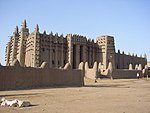
Imperial Mali is best known to us through three primary sources: The first is the account of Shihab al-Din ibn Fadl Allah al-'Umari, written about 1340 by a geographer-administrator in Egypt. His information about the empire came from visiting Malians taking the hajj, or pilgrim's voyage to Mecca. He had first hand information from several, and at second hand, he learned of the visit of Mansa Musa. The second account is that of the traveler Shams al-Din Abu Abd'Allah ibn Battua, who visited Mali in 1352. This is the first account of a West African kingdom made directly by an eyewitness, the others are usually at second hand. The third great account is that of Abu Zayd Abd-al-Rahman ibn Khaldun, who wrote in the early 15th century. While the accounts are of limited length, they provide us with a fairly good picture of the empire at its height.
Ethiopian Empire
- 1137 - 1975
The Ethiopian Empire (Abyssinia) existed at the end of the late Middle Ages, approximately 1137 (beginning of Zagwe Dynasty). In 1270, the Zagwe dynasty was overthrown by a king claiming lineage with the Aksumite emperors and thus that of Solomon (hence the name "Solomonid"). The Solomonid Dynasty was born of and ruled by the Habesha, from whom Abyssinia gets its name. The Habesha reigned with only a few interruptions from 1270 until the modern age.
Medieval India
Chalukya Empire
- 543–753
| Chalukya Empire |
|---|
 |
The Chalukya Empire was an Indian royal dynasty that ruled large parts of southern and central India between the 6th and the 12th centuries. The rule of the Chalukyas marks an important milestone in the history of South India and a golden age in the history of Karnataka.

The political atmosphere in South India shifted from smaller kingdoms to large empires with the ascendancy of Badami Chalukyas. For the first time, a South Indian kingdom took control and consolidated the entire region between the Kaveri and the Narmada rivers. The rise of this empire saw the birth of efficient administration, overseas trade and commerce and the development of new style of architecture called "Badami Chalukya architecture (Western Chalukya architecture during the rule of Western Chalukyas)".
The Chalukyas ruled over the Deccan plateau in India for over 600 years. During this period, they ruled as three closely related, but individual dynasties. These are the "Chalukyas of Badami" (also called "Early Chalukyas"), who ruled between the 6th and the 8th century, and the two sibling dynasties, the "Chalukyas of Kalyani" (also called Western Chalukyas or "Later Chalukyas") and the "Chalukyas of Vengi" (also called Eastern Chalukyas).
Vikramaditya VI was an ambitious and skilled military leader. Under his leadership the Western Chalukyas were able to end the Chola influence over Vengi (coastal Andhra) and become the dominant power in the Deccan. The Western Chalukya period was an important age in the development of Kannada literature and Sanskrit literature. They went into their final dissolution towards the end of the 12th century.
Further information: Aihole; Pattadakal; Mahakuta; Badami; Western Chalukyas; Western Chalukya architecture; Lakkundi; Mahadevatemple, Itagi; and annigeriRashtrakuta Empire
- 753–982
| Rashtrakuta Empire |
|---|
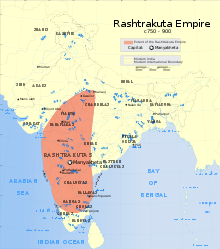 |
The Rashtrakuta Empire was a royal Indian dynasty ruling large parts of southern, central and northern India between the 6th and the 10th centuries. An Arabic writing, the Silsilatuttavarikh (851) called the Rashtrakutas one among the four principle empires of the world. The Kitab-ul-Masalik-ul-Mumalik (912) called them the "greatest kings of India" and there were other contemporaneous books written in their praise.
The Rashtrakutas quickly became the most powerful Deccan empire, making their initial successful forays into the doab region of Ganges River and Jamuna River during the rule of Dhruva Dharavarsha. The rule of his son Govinda III signaled a new era with Rashtrakuta victories against the Pala Dynasty of Bengal and Gurjara Pratihara of north western India resulting in the capture of Kannauj. The Rashtrakuta empire at its peak spread from Cape Comorin in the south to Kannauj in the north and from Banaras in the east to Broach (Bharuch) in the west.
The Carnatic expansion of people and influences to the North from Karnataka during 10-12th century period is well attested by the sources but has not yet been studied carefully.
See also: Branches of Rashtrakuta Dynasty, Economy of Rashtrakuta empire of Manyakheta, and Society of Rashtrakuta empire of ManyakhetaPala Empire
- 750–1174
| Pala Empire |
|---|
The Pala Empire was a Buddhist dynasty that ruled from the north-eastern region of the Indian subcontinent. The Palas were followers of the Mahayana and Tantric schools of Buddhism. Gopala was the first ruler from the dynasty. He came to power in 750 in Gaur by a democratic election.
The empire reached its peak under Dharmapala and Devapala. Dharmapala extended the empire into the northern parts of the Indian Subcontinent. This triggered once again the power struggle for the control of the subcontinent. Devapala, successor of Dharmapala, expanded the empire to cover much of South Asia and beyond. His empire stretched from Assam and Utkala in the east, Kamboja (modern day Afghanistan) in the north-west and Deccan in the south.
The Pala Empire can be considered as the golden era of Bengal. Never had the Bengali people reached such height of power and glory to that extent. The Palas had extensive trade as well as influence in south-east Asia. This can be seen in the sculptures and architectural style of the Sailendra Empire (present-day Malaya, Java, Sumatra). The Pala Empire eventually disintegrated in the 12th century weakened by attacks of the Sena dynasty followed by the invasion of Bakhtiyar Khilji's Muslim armies.
Medieval Southeast Asia
Khmer Empire
- 802-1431
| Khmer Empire |
|---|
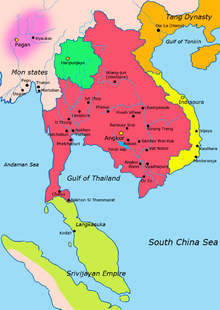 |

The Khmer Empire was one of the most powerful empires in Southeast Asia, based in what is now Cambodia. The empire, which grow out of former kingdom of Chenla, at times ruled over and/or vassalized parts of modern-day Laos, Thailand, Vietnam, Myanmar, and Malaysia. Its greatest legacy is Angkor, the site of capitals cities during the empire's zenith. Angkor bears testimony to the Khmer empire's immense power and wealth, as well as the variety of belief systems that it patronised over time. The empire's official religions included Hinduism and Mahayana Buddhism, until Theravada Buddhism prevailed, even among plain folks, after its introduction from Sri Lanka as of the 13th century. Modern researches by satellites have revealed Angkor to be the largest pre-industrial urban center in the world.
From Kambuja itself - and so also from the Angkor region - no written records have survived other than stone inscriptions. Therefore the current knowledge of the historical Khmer civilization is derived primarily from:
- archaeological excavation, reconstruction and investigation
- stone inscriptions (most important are foundation steles of temples), which report on the political and religious deeds of the kings
- reliefs in a series of temple walls with depictions of military marches, life in the palace, market scenes and also the everyday lives of the population
- reports and chronicles of Chinese diplomats, traders and travellers.

The beginning of the era of the Khmer Empire is conventionally dated to 802 AD. In this year, king Jayavarman II had himself declared chakravartin ("king of the world", or "king of kings") on Phnom Kulen.
The 11th century was a time of conflict and brutal power struggles. Only with Suryavarman II was the kingdom united internally and extended externally. Under his rule, the largest temple of Angkor was built in a period of 37 years: Angkor Wat, dedicated to the god Vishnu. Suryavarman II conquered the Mon kingdom of Haripunjaya to the west, and the area further west to the border with the kingdom of Bagan, in the south further parts of the Malay peninsula down to the kingdom of Grahi, in the east several provinces of Champa and the countries in the north as far as the southern border of modern Laos. Suryavarman II's end is unclear. The last inscription, which mentions his name in connection with a planned invasion of Vietnam, is from the year 1145. He died during a failed military expedition in Đại Việt territory around 1145 and 1150.
Srivijaya
Main article: Srivijaya| Srivijaya |
|---|
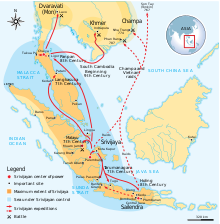 |
The First Nusantara Kingdom (Srivijaya Empire) has success uniting most western part of Nusantara or maritime Southeast Asia. Srivijaya was a coastal trading centre and was a thalassocracy. As such, it did not extend its influence far beyond the coastal areas of the islands of Southeast Asia, with the exception of contributing to the population of Madagascar 3,300 miles to the west.
According to the Kota Kapur Inscription, discovered on Bangka Island, the empire conquered most of Southern Sumatra and neighboring island of Bangka, as far as Lampung. Also according to this inscription, Jayanasa launched a military campaign against Bhumi Java in late 7th century, a period which coincides with the decline of Tarumanagara in West Java and Holing (Kalingga) in Central Java. The empire thus grew to control the trade on the Strait of Malacca, Sunda Strait, the South China Sea, the Java Sea, and Karimata Strait.During the same century, Langkasuka on the Malay Peninsula became part of Srivijaya. Soon after this, Pan Pan and Trambralinga, which were located north of Langkasuka, came under Srivijayan influence. These kingdoms on the peninsula were major trading nations that transported goods across the peninsula's isthmus. With the expansion into Java and the Malay Peninsula, Srivijaya controlled two major trade choke points in Southeast Asia. Some Srivijayan temple ruins are observable in Thailand and Cambodia.
At some point in the 7th century, Cham ports in eastern Indochina started to attract traders. This diverted the flow of trade from Srivijaya. In an effort to divert the flow, the Srivijayan king or maharaja, Dharmasetu, launched various raids against the coastal cities of Indochina. The city of Indrapura by the Mekong River was temporarily controlled from Palembang, capital of the empire during the century, in the early 8th century. By that century, Srivijaya controlled both the spice route traffic and local trade, charging a toll on passing ships. Serving as an entrepôt for Chinese, Malay, and Indian markets, the port of Palembang, accessible from the coast by way of a river, accumulated great wealth. Envoys travelled to and from China frequently.
The migration to Madagascar accelerated in the 9th century, when the powerful Sumatran empire of Srivijaya controlled much of the maritime trade in the Indian Ocean.
American Precolumbian Empires
Maya Civilization
Main article: Maya Civilization
The Maya is a Mesoamerican civilization, noted for the only known fully developed written language of the pre-Columbian Americas, as well as its art, architecture, and mathematical and astronomical systems. Initially established during the Preclassic period (c. 2000 BC to 250 AD), many Maya cities reached their highest state development during the Classic period (c. 250 to 900), and continued throughout the Postclassic period until the arrival of the Spanish. At its peak, it was one of the most densely populated and culturally dynamic societies in the world.

The Maya civilization shares many features with other Mesoamerican civilizations due to the high degree of interaction and cultural diffusion that characterized the region. Advances such as writing, epigraphy, and the calendar did not originate with the Maya; however, their civilization fully developed them. Maya influence can be detected from Honduras, Guatemala, Northern El Salvador and to as far as central Mexico, more than 1,000 km (620 mi) from the Maya area. Many outside influences are found in Maya art and architecture, which are thought to result from trade and cultural exchange rather than direct external conquest.
The Classic period (c. 250–900 AD) witnessed the peak of large-scale construction and urbanism, the recording of monumental inscriptions, and a period of significant intellectual and artistic development, particularly in the southern lowland regions. They developed an agriculturally intensive, city-centered empire consisting of numerous independent city-states. This includes the well-known cities of Tikal, Palenque, Copán and Calakmul, but also the lesser known Dos Pilas, Uaxactun, Altun Ha, and Bonampak, among others.
Inca Empire
Main article: Inca Empire| Inca Empire |
|---|
 |
The Inca Empire was the largest empire in pre-Columbian America. The administrative, political and military center of the empire was located in Cusco in modern-day Peru. The Inca Empire arose from the highlands of Peru sometime in early 13th century. From 1438 to 1533, the Incas used a variety of methods, from conquest to peaceful assimilation, to incorporate a large portion of western South America, centered on the Andean mountain ranges, including large parts of modern Ecuador, Peru, western and south central Bolivia, northwest Argentina, north and north-central Chile, and southern Colombia.
 |
 |
 |
There is some debate about the number of people inhabiting Tawantinsuyu at its peak, with estimates ranging from as few as 4 million people, to more than 37 million. The reason for these various estimates is that in spite of the fact that the Inca kept excellent census records using their quipu, knowledge of how to read them has been lost, and almost all of them had been destroyed by the Spaniards in the course of their conquest.
The most powerful figure in the empire was the Sapa Inca ('the unique Inca'). Only descendants of the original Inca tribe ascended to the level of Inca. Most young members of the Inca's family attended Yachay Wasis (houses of knowledge) to obtain their education.
The Inca Empire was a federalist system which consisted of a central government with the Inca at its head and four provinces. The four corners of these provinces met at the center, Cusco. Each province had a governor who oversaw local officials, who in turn supervised agriculturally productive river valleys, cities and mines. The local officials were responsible for settling disputes and keeping track of each family's contribution to the mita (mandatory public service).
Architecture was by far the most important of the Inca arts, with textiles reflecting motifs that were at their height in architecture. The main example is the capital city of Cusco. The breathtaking site of Machu Picchu was constructed by Inca engineers. The stone temples constructed by the Inca used a mortarless construction that fit together so well that a knife could not be fitted through the stonework. This was a process first used on a large scale by the Pucara peoples (ca. 300 BC–AD 300) and later in the great city of Tiwanaku (ca. AD 400–1100). The rocks used in construction were sculpted to fit together exactly by repeatedly lowering a rock onto another and carving away any sections on the lower rock where the dust was compressed. The tight fit and the concavity on the lower rocks made them extraordinarily stable.
Aztec Empire
Main article: Aztec
The Aztec people were certain ethnic groups of central Mexico, particularly those groups who spoke the Nahuatl language and who dominated large parts of Mesoamerica in the 14th, 15th and 16th centuries, a period referred to as the Late post-Classic period in Mesoamerican chronology. From the 13th century Valley of Mexico was the core of Aztec civilization: here the capital of the Aztec Triple Alliance, the city of Tenochtitlan, was built upon raised islets in Lake Texcoco. The Triple Alliance formed its tributary empire expanding its political hegemony far beyond the Valley of Mexico, conquering other city states throughout Mesoamerica. In 1521, in what is probably the most widely known episode in the Spanish colonization of the Americas, Hernán Cortés, along with a large number of Nahuatl speaking indigenous allies, conquered Tenochtitlan and defeated the Aztec Triple Alliance under the leadership of Hueyi Tlatoani Moctezuma II; In the series of events often referred to as "The Fall of the Aztec Empire". Subsequently the Spanish founded the new settlement of Mexico City on the site of the ruined Aztec capital.

The Aztec Empire was an example of an empire that ruled by indirect means. It was ethnically very diverse and was structured by a system of tribute. The Aztec empire as an hegemonic empire did not exert supreme authority over the conquered lands, it merely expected tributes to be paid. It was also a discontinuous empire because not all dominated territories were connected. The hegemonic nature of the Aztec empire can be seen in the fact that generally local rulers were restored to their positions once their city-state was conquered and the Aztecs did not interfere in local affairs as long as the tribute payments were made. Although the form of government is often referred to as an empire, in fact most areas within the empire were organized as city-states, known as altepetl. These were small polities ruled by a king (tlatoani) from a legitimate dynasty.
Modern powers
Early modern powers
- 1492-1815
- Early Modern history
France
- 1450s - 1815
| French colonial empire |
|---|
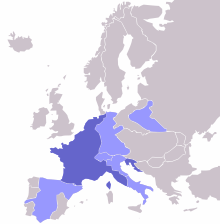 |
 |
France was a dominant empire possessing many colonies in various locations around the world. The Empire of the French (1804–1814), also known as the Greater French Empire or First French Empire, but more commonly known as the Napoleonic Empire, was the empire of Napoleon I in France. It was the dominant power of much of continental Europe during the early 19th Century.
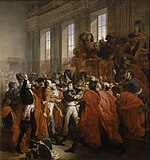
Napoleon became Emperor of the French (L'Empereur des Français) on 18 May 1804 and crowned Emperor 2 December 1804, ending the period of the French Consulate, and won early military victories in the War of the Third Coalition against Austria, Prussia, Russia, Portugal, and allied nations, notably at the Battle of Austerlitz (1805) and the Battle of Friedland (1807). The Treaty of Tilsit in July 1807 ended two years of bloodshed on the European continent. Subsequent years of military victories known collectively as the Napoleonic Wars extended French influence over much of Western Europe and into Poland. At its height in 1812, the French Empire had 130 départements, ruled over 50 million subjects, maintained extensive military presence in Germany, Italy, Spain, and the Duchy of Warsaw, and could count Prussia and Austria as nominal allies.
Early French victories exported many ideological features of the French Revolution throughout Europe. Napoleon gained support by appealing to some common concerns of French people. These included dislike of the emigrant nobility who had escaped persecution, fear by some of a restoration of the ancien régime, a dislike and suspicion of foreign countries had tried to reverse the Revolution – and a wish by Jacobins to extend France's revolutionary ideals. Seigneurial dues and seigneurial justice were abolished, aristocratic privileges were eliminated in all places except Poland, and the introduction of the Napoleonic Code throughout the continent increased legal equality, established jury systems, and legalized divorce. Napoleon placed relatives on the thrones of several European countries and granted many noble titles, most of which expired with the fall of the Empire.

Historians have estimated the death toll from the Napoleonic Wars to be 6.5 million people, or 15% of the French Empire's subjects. The War of the Sixth Coalition, a coalition of Austria, Prussia, Russia, the United Kingdom, Sweden, Spain and a number of German States finally defeated France and drove Napoleon Bonaparte into exile on Elba. After Napoleon's disastrous invasion of Russia, the continental powers joined Russia, Britain, Portugal and the rebels in Spain. With their armies reorganized, they drove Napoleon out of Germany in 1813 and invaded France in 1814, forcing Napoleon to abdicate and restoring the Bourbons.
See also: Napoleon's Invasion of Russia and Hundred DaysModern Venetian Republic
- 1489–1718
In the high Middle Ages the Republic of Venice was able to become a very wealthy and powerful state through the rich trade between Europe and the Levant. During the Modern Era started the decline of Venice, but it was a very long and "golden" decadence, in fact for almost three centuries the Republic was the only Italian state able to preserve his independence; in particular Venice was able to match the invading powers of the French and Spanish monarchies in Italy and in the same time, the Republic was also able to stop many times the expansion of Ottoman Empire in South-East Europe and Mediterranean. The last main success of Venice was the conquest of Morea between 1669 and 1718. The Republic of Venice ended in 1797 when Napoleon conquered the city and ceded its territories to Austria.
Qing Empire
- 1660s - 1700s
| Qing Empire |
|---|
 |
The Qing Dynasty was the last ruling dynasty of China, ruling from 1644 to 1912 (with a brief, abortive restoration in 1917). It was preceded by the Ming Dynasty and followed by the Republic of China. The dynasty was founded by the Manchu clan Aisin Gioro in what is today northeast China (also known as Manchuria). Starting in 1644 it expanded into China proper and its surrounding territories, establishing the Empire of the Great Qing. Complete pacification of China was accomplished around 1683 under the Kangxi Emperor.

The dynasty changed its name to "Qing", meaning "clear" or "pellucid" around 1636. In 1644 Beijing was sacked by a coalition of rebel forces led by Li Zicheng, a minor Ming official turned leader of the peasant revolt. The last Ming Emperor Chongzhen committed suicide when the city fell, marking the official end of the dynasty. The Manchus then allied with Ming Dynasty general Wu Sangui and seized control of Beijing and overthrew Li's short-lived Shun Dynasty.
During its reign the Qing Dynasty became highly integrated with Chinese culture. The dynasty reached its height in the 18th century, during which both territory and population were increased. However, its military power weakened hereafter and faced with massive rebellions and defeats in wars, the Qing Dynasty declined after the mid-19th century. The Qing Dynasty was overthrown following the Xinhai Revolution.
Safavid Empire
- 1501-1736
| Safavid dynasty |
|---|
 |
The Safavid Empire was one of the most significant ruling dynasties of Iran. They ruled one of the greatest Iranian Empires after the Muslim conquest of Persia The Safavids ruled from 1501 to 1736 and at their height, they controlled all of modern Iran, Azerbaijan and Armenia, most of Iraq, Georgia, Afghanistan, and the Caucasus, as well as parts of Pakistan, Turkmenistan and Turkey. Safavid Iran was one of the Islamic "gunpowder empires", along with its neighbours, the Ottoman and Mughal empires. The Safavid empire originated from Ardabil in Iran and had its origins in a long established Sufi order, called the Safaviyeh. The Safavids established an independent unified Iranian state for the first time after the Muslim conquest of Persia and reasserted Iranian political identity, and established Shia Islam as the official religion in Iran.
Despite their demise in 1736, the legacy that they left behind was the revival of Iran as an economic stronghold between East and West, the establishment of an efficient state and bureaucracy based upon "checks and balances", their architectural innovations and their patronage for fine arts. The Safavids have also left their mark down to the present era by spreading Shi'a Islam in Iran, as well as major parts of the Caucasus, South Asia, Central Asia, and Anatolia.
Dutch Republic
- 1581–1795
| Dutch Empire |
|---|
 |
The Dutch Republic controlled various territories after the Dutch achieved independence from Spain in the 16th century. Their skills in shipping and trading aided the building of an overseas colonial empire which lasted from the 16th to the 20th century. The Dutch initially built up colonial possessions on the basis of indirect state capitalist corporate colonialism, with the dominant Dutch East India Company. A cultural flowering roughly spanning the 17th century is known as the Dutch Golden Age, in which Dutch trade, science and art were among the most acclaimed in the world. Dutch military power was at its height in the middle of the 17th century and in that era the Dutch navy was the most powerful navy in the world.
By the middle of the 17th century, the Dutch had overtaken Portugal as the dominant player in the spice and silk trade, and in 1652 founded a colony at Cape Town on the coast of South Africa, as a way-station for its ships on the route between Europe and Asia. After the first settlers spread out around the Company station, nomadic white livestock farmers, or Trekboers, moved more widely afield, leaving the richer, but limited, farming lands of the coast for the drier interior tableland. Between 1602 and 1796, million Europeans were sent to work in the Asia trade. The majority died of disease or made their way back to Europe, but some of them made the Indies their new home. Interaction between the Dutch and native population mainly took place in Sri Lanka and the modern Indonesian Islands. Through the centuries there developed a relatively large Dutch-speaking population of mixed Dutch and Indonesian descent, known as Indos or Dutch-Indonesians.
Early British Empire
- 1600–1815
| British Empire |
|---|
 |
|
The empire began in the 17th century as a combination of factors led to its creation, such as the growth in British trade with India and the Far East, the success of the British East India Company, numerous British maritime explorations around the world, and the vast Royal Navy. The British Empire comprised the dominions, colonies, protectorates, mandates, and other territories ruled or administered by the United Kingdom. It originated with the overseas colonies and trading posts established by England in the late 16th and early 17th centuries. At its height it was the largest empire in history and, for over a century, was the foremost global power. It is widely accepted that during the period known as the Pax Brittanica the Empire was the most powerful unitary authority in human history due to the unprecedented level of predominance which the United Kingdom experienced at this time.
British colonies were created along the east coast of North America during the 17th and 18th centuries but by the late 18th century most of these colonies rebelled against British rule, leading to the American War of Independence and formation of the United States of America. Nevertheless Great Britain retained significant colonies in Canada, the Caribbean and India, and shortly thereafter began the settlement of Australia and New Zealand. Following France's defeat in the Napoleonic Wars in 1815, Great Britain took possession of many more overseas territories in Africa and Asia, and established informal empires of free trade in South America, China and Persia.
Mughal Empire
- 1526 - 1857
| Mughal Empire |
|---|
 |
The Mughal Empire was an Turkic-Mongol imperial power from Uzbekistan, that ruled most of the Indian subcontinent in 16th and 17th century. In 1526, Babur, a Timurid descendant of Timur and Genghis Khan from Fergana Valley in Uzbekistan, swept across the Khyber Pass and established the Mughal Empire, which lasted for over 200 years. The Mughal Dynasty ruled most of the Indian subcontinent by 1600; it went into a slow decline after 1707 and was finally defeated during the 1857 War of Independence also called the Indian Rebellion of 1857. The famous emperor Akbar, who was the grandson of Babur, tried to establish an inclusive empire. However, later emperors such as Aurangazeb attempted to expand the empire beyond its previous limitations and during this period taxes imposed on non-Muslims. The Mughals were perhaps the richest single empire to have ever existed.
Early Ottoman Empire
- 1400s - 1815
| Ottoman Empire |
|---|
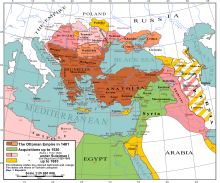 |
|
the Ottoman Empire was a Turkish state, which at the height of its power (16th - 17th centuries) spanned three continents (see: extent of Ottoman territories) controlling much of Southeastern Europe, the Middle East and most of North Africa. The empire has been called by historians a "Universal Empire" due to both Roman and Islamic traditions.
The empire was at the center of interactions between the Eastern and Western worlds for six centuries. The Ottoman Empire was the only Islamic power to seriously challenge the rising power of Western Europe between the 15th and 19th centuries. With Istanbul (or Constantinople) as its capital, the Empire was in some respects an Islamic successor of earlier Mediterranean empires - the Roman and Byzantine empires.
Ottoman military reform efforts begin with Selim III (1789–1807) who made the first major attempts to modernize the army along European lines. These efforts, however, were hampered by reactionary movements, partly from the religious leadership, but primarily from the Janissary corps, who had become anarchic and ineffectual. Jealous of their privileges and firmly opposed to change, they created a Janissary revolt. Selim's efforts cost him his throne and his life, but were resolved in spectacular and bloody fashion by his successor, the dynamic Mahmud II, who massacred the Janissary corps in 1826.
The effective military and bureaucratic structures of the previous century also came under strain during a protracted period of misrule by weak Sultans. But in spite of these difficulties, the Empire remained a major expansionist power until the Battle of Vienna in 1683, which marked the end of Ottoman expansion into Europe.
Poland-Lithuania
- 1569–1795
| Polish–Lithuanian Commonwealth |
|---|
 |
The Polish-Lithuanian Commonwealth was one of the largest, most powerful and most populous countries in 16th, 17th, and 18th century Europe. Its political structure — that of a semi-federal, semi-confederal noble republic — was formed in 1569 by the Union of Lublin, which united the Kingdom of Poland and the Grand Duchy of Lithuania, and lasted in this form until the adoption of the Constitution of May 3, 1791.
The Union possessed features unique among contemporary states. This political system unusual for its time stemmed from the ascendance of the szlachta noble class over other social classes and over the political system of monarchy. In time, the szlachta accumulated enough privileges (such as those established by the Nihil novi Act of 1505) that no monarch could hope to break the szlachta's grip on power. The Commonwealth's political system is difficult to fit into a simple category, but it can be tentatively described as a mixture of:
- confederation and federation, with regard to the broad autonomy of its regions. It is, however, difficult to decisively call the Commonwealth either confederation or federation, as it had some qualities of both of them;
- oligarchy, as only the szlachta—around 15% of the population—had political rights;
- democracy, since all the szlachta were equal in rights and privileges, and the Sejm could veto the king on important matters, including legislation (the adoption of new laws), foreign affairs, declaration of war, and taxation (changes of existing taxes or the levying of new ones). Also, the 15% of Commonwealth population who enjoyed those political rights (the szlachta) was a substantially larger percentage than in majority European countries; note that in 1789 in France only about 1% of the population had the right to vote, and in 1867 in the United Kingdom, only about 3%.
- elective monarchy, since the monarch, elected by the szlachta, was Head of State;
- constitutional monarchy, since the monarch was bound by pacta conventa and other laws, and the szlachta could disobey any king's decrees they deemed illegal.
Portugal
- 1415 - 2002
| Portuguese Empire |
|---|
 |
The Portuguese Empire was the first global empire in history, and also the earliest and longest lived of the Western European colonial empires, existing from 1415 to 1999. Portugal's small size and population restricted the empire to a collection of small but well defended outposts along the shoreline. The height of the empire power was reached in the 16th century but the indifference of the Habsburg kings and the competition with new colonial empires like the British, French and Dutch started its long and gradual decline. After the 18th century Portugal concentrated in the colonization of Brazil and African possessions.
Between the Spanish and Portuguese, the Treaty of Tordesillas divided the world outside of Europe in an exclusive duopoly along a north-south meridian 370 leagues, or 970 miles (1,560 km), west of the Cape Verde islands. However, as it was not possible at the time to correctly measure longitude, the exact boundary was disputed by the two countries until 1777. The completion of these negotiations with Spain is one of several reasons proposed by historians for why it took nine years for the Portuguese to follow up on Dias's voyage to the Cape of Good Hope, though it has also been speculated that other voyages were in fact taking place in secret during this time. Whether or not this was the case, the long-standing Portuguese goal of finding a sea route to Asia was finally achieved in a ground-breaking voyage commanded by Vasco da Gama.
Prussia
Main article: PrussiaThe Kingdom of Prussia dominated northern Germany politically, economically, and in terms of population, and was the core of the unified North German Confederation formed in 1867, which became part of the German Empire or Deutsches Reich in 1871.
Prussia attained its greatest importance in the 18th and 19th centuries. During the 18th century, it became a European great power under the reign of Frederick II of Prussia (1740–86). During the 19th century, Chancellor Otto von Bismarck pursued a policy of uniting the German principalities into a "Lesser Germany" which would exclude the Austrian Empire.
Early Spanish Empire
- 1492-1815
| Spanish Empire |
|---|
 |
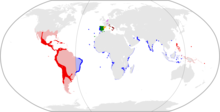 |
|
In the 16th century Spain and Portugal were in the vanguard of European global exploration and colonial expansion and the opening of trade routes across the oceans, with trade flourishing across the Atlantic Ocean between Spain and the Americas and across the Pacific Ocean between Asia-Pacific and Mexico via the Philippines. Conquistadors toppled the Aztec, Inca, and Maya civilizations, and laid claim to vast stretches of land in North and South America. For a time, the Spanish Empire dominated the oceans with its navy and ruled the European battlefield with its infantry, the famous tercios. Spain enjoyed a cultural golden age in the 16th and 17th centuries as Europe's foremost power.
From 1580 to 1640 the Portuguese Empire and the Spanish Empire were conjoined in a personal union of its Habsburg monarchs, during the period of the Iberian Union, though the empires continued to be administered separately.
From the middle of the 16th century silver and gold from the American mines increasingly financed the military capability of Habsburg Spain in its long series of European and North African wars. Until the loss of its American colonies in the 19th century, Spain maintained one of the largest empires in the world, even though it suffered fluctuating military and economic fortunes from the 1640s. Confronted by the new experiences, difficulties and suffering created by empire-building, Spanish thinkers formulated some of the first modern thoughts on natural law, sovereignty, international law, war, and economics — they even questioned the legitimacy of imperialism — in related schools of thought referred to collectively as the School of Salamanca.
Constant contention with rival powers caused territorial, commercial, and religious conflict that contributed to the slow decline of Spanish power from the mid-17th century. In the Mediterranean, Spain warred constantly with the Ottoman Empire; on the European continent, France became comparably strong. Overseas, Spain was initially rivaled by Portugal, and later by the English and Dutch. In addition, English-, French-, and Dutch-sponsored privateering and piracy, overextension of Spanish military commitments in its territories, increasing government corruption, and economic stagnation caused by military expenditures ultimately contributed to the empire's weakening.
Spain's European empire was finally undone by the Peace of Utrecht (1713), which stripped Spain of its remaining territories in Italy and the Low Countries. Spain's fortunes improved thereafter, but it remained a second rate power in Continental European politics. However, Spain maintained and enlarged its vast overseas empire until the 19th century, when the shock of the Peninsular War sparked declarations of independence in Quito (1809), Venezuela and Paraguay (1811) and successive revolutions that split away its territories on the mainland (the Spanish Main) of the Americas.
Sweden
Main article: Swedish Empire| Swedish Empire |
|---|
 |
The 17th century saw the rise of Sweden as one of the Great Powers in Europe. Sweden also had colonial possessions as a minor colonial Empire that existed from 1638–1663 and later 1784-1878.
The mid-17th and early 18th centuries were Sweden's most successful years as a Great Power. Sweden reached its largest territorial extent during the rule of Charles X (1622–1660) after the treaty of Roskilde in 1658. However, after more than a half century of almost constant warfare the Swedish economy had deteriorated. It would become the lifetime task of Charles' son, Charles XI (1655–1697), to rebuild the economy and refit the army. His legacy to his son, the coming ruler of Sweden Charles XII, was one of the finest arsenals in the world, a large standing army and a great fleet. Sweden's largest threat at this time, Russia, had a larger army but was far behind in both equipment and training. The Swedish army crushed the Russians at the Battle of Narva in 1700, one of the first battles of the Great Northern War. This led to an overambitious campaign against Russia in 1707, however, ending in a decisive Russian victory at the Battle of Poltava (1709). The campaign had a successful opening for Sweden, which came to occupy half of Poland and making Charles able to claim the Polish throne. But after a long march exposed by cossack raids, the Russian Tsar Peter the Great's scorched-earth techniques and the cold Russian climate, the Swedes stood weakened with a shattered confidence, and enormously outnumbered against the Russian army at Poltava. The defeat meant the beginning of the end for Sweden as an empire.
Moscovian Empire and after
- 1400-1815
| Russian Empire |
|---|
 |
|
The Russian Empire formed from what was Tsardom of Russia under Peter the Great. Peter I, (1672–1725), played a major role in bringing his country into the European state system, and laid the foundations of a modern state in Russia. From its modest beginnings in the 14th century, Russia had become the largest state in the world by Peter's time. Three times the size of continental Europe, it spanned the Eurasian landmass from the Baltic Sea to the Pacific Ocean.
Maratha Empire
- 1674–1820
| Maratha Empire |
|---|
 |
The Maratha Empire (Maratha Confederacy) was a Hindu state located in present-day India. It existed from 1674 to 1818. At its peak, the empire's territories covered much of South Asia. It expanded greatly after the death of Mughal Emperor Aurangzeb in 1707, only to lose Punjab region in Third battle of Panipat in 1761. A large portion of the empire was coastline which was secured by a potent navy under commanders such as Kanhoji Angre. He was very successful at keeping foreign naval ships, particularly of the Portuguese and British, at bay. Securing the coastal areas and building land-based fortifications were crucial aspects of the Maratha's defensive strategy and regional military history.
The Maratha Empire was at its height in the 18th century under Shahu and the Peshwa Baji Rao I. Losses at the Third Battle of Panipat in 1761 suspended further expansion of the empire in the North-west and reduced the power of the Peshwas. In 1761, after severe losses in the Panipat war, the Peshwas slowly started losing the control of the kingdom. Many military chiefs of the Maratha Empire like Shinde, Holkar, Gaikwad, Pant Pratinidhi, Bhosale of Nagpur, Pandit of Bhor, Patwardhan, and Newalkar started to work towards their ambition of becoming kings in their respective regions. However, under Madhavrao Peshwa, Maratha authority in North India was restored, 10 years after the battle of Panipat.
After the death of Madhavrao, the empire gave way to a loose Confederacy, with political power resting in a 'pentarchy' of five mostly Maratha dynasties: the Peshwas of Pune; the Sindhias (originally "Shindes") of Malwa and Gwalior; the Holkars of Indore; the Bhonsles of Nagpur; and the Gaekwads of Baroda. A rivalry between the Sindhia and Holkar dominated the confederation's affairs into the early 19th century, as did the clashes with the British and the British East India Company in the three Anglo-Maratha Wars. In the Third Anglo-Maratha War, the last Peshwa, Baji Rao II, was defeated by the British in 1818. Most of the former Maratha Empire was absorbed by British India, although some of the Maratha states persisted as quasi-independent princely states until India became independent in 1947.
High modern historical powers
- 19th, 20th, and 21st centuries
- Late Modern and Contemporary history
Persian Qajar Empire
- 1794–1925
The Empire of Persia under the Qajar dynasty during the 19th century was still a considerable power, with a considerable extension of territories; but during the century it was not able to prevent the expansion of other powers, so the empire lost some external territories and by 1907 it was divided under spheres of influence by the Russian and the British empires.
The Netherlands
- 1815–1949
The Kingdom of the Netherlands was a major colonial power in the 19th and 20th century until the independence recognition of Indonesia in 1949. The last major colony Suriname became independent in 1975 and since then only the islands of the former Netherlands Antilles are part of the Kingdom.
France
- 1815–1956
| French colonial empire |
|---|
 |
France was a dominant empire possessing many colonies in various locations around the world. The French colonial empire is the set of territories outside Europe that were under French rule primarily from the 17th century to the late 1960s (some see the French control of places such as New Caledonia as a continuation of that colonial empire). In the 19th and 20th centuries, the colonial empire of France was the second largest in the world behind the British Empire. The French colonial empire extended over 12,890,000 km (4,980,000 sq mi) of land at its height in the 1920s and 1930s. Including metropolitan France, the total amount of land under French sovereignty reached 13,500,000 km (5,200,000 sq mi) at the time, which is 8.7% of the Earth's total land area.
France began to establish colonies in North America, the Caribbean and India, following Spanish and Portuguese successes during the Age of Discovery, in rivalry with Britain for supremacy. A series of wars with Britain during the 18th and early 19th centuries which France lost ended its colonial ambitions on these continents, and with it is what some historians term the "first" French colonial empire. In the 19th century, France established a new empire in Africa and South East Asia. Some of these colonies lasted beyond the Second World War.
Late British Empire
- 1815–1956
| British Empire |
|---|
 |
|
The British Empire was the largest empire in world history. It was after this period during the 19th century that the United Kingdom became the first country in the world to industrialise and embrace free trade, giving birth to the Industrial Revolution. This rapid industrial growth transformed Great Britain into the world's largest industrial and financial power, while the world's largest navy gave it undisputed control of the seas and international trade routes, an unassailable advantage which helped the British Empire, after a mid-century liberal reaction against empire-building, to grow faster than ever before. The Victorian empire colonised large parts of Africa, including such territories as South Africa, Egypt, Kenya, Sudan, Nigeria, and Ghana, most of Oceania, colonies in the Far East, such as Singapore, Malaysia, and Hong Kong, and took control over all the Indian Subcontinent, making it the largest empire in the world.
After victory in the First World War the empire gained control of territories such as Tanzania, and Namibia, from the German Empire, and Iraq, and Palestine from the Ottoman Empire. By this point in 1920 the British empire had grown to become the largest empire in history, controlling approximately 25% of the world's land surface and 25% of the world's population. It covered about 36.6 million km² (14.2 million square miles). Because of its magnitude, it was often referred to as the empire on which the sun never sets.
The political and social changes and economic disruption in the United Kingdom and throughout the world caused by First World War followed only two decades later by the Second World War caused the empire to gradually break up as colonies were given independence. Much of the reason the empire ceased was because many colonies by the mid-20th century were no longer as undeveloped as at the arrival of British control nor as dependent and social changes throughout the world during the first half of the 20th century gave rise to national identity. The British Government, reeling from the economic cost of two successive world wars and changing social attitudes towards empire, felt it could no longer afford to maintain it if the country were to recover economically, pay for the newly created welfare state, and fight the newly emerged Cold War with the Soviet Union.
So the influence and the power of the British Empire dropped dramatically after the Second World War, especially after the independence of India in 1947 and the Suez Crisis 1956. The Commonwealth of Nations was the successor to the empire, where the United Kingdom is an equal member with all other states.
Late Spanish Empire
- 1815–1898
| Spanish Empire |
|---|
 |
|
After the Napoleonic period the Bourbon dynasty was restored in Spain and over the huge amount of Spanish territories around the world. But the shock of the Peninsular War sparked declarations of independence in the Latin America controlled by Spain and by 1835 successive revolutions signed the end of the Spanish rule over the majority of this countries. Spain retained significant fragments of its empire in the Caribbean (Cuba and Puerto Rico); Asia (Philippines); and Oceania (Guam, Micronesia, Palau, and Northern Marianas) until the Spanish–American War of 1898. Spanish participation in the Scramble for Africa was minimal: Spanish Morocco was held until 1956 and Spanish Guinea and the Spanish Sahara were held until 1968 and 1975 respectively. The Canary Islands, Ceuta, Melilla and the other Plazas de Soberanía on the northern African coast have remained part of Spain.
Austrian Empire (Austria-Hungary)
- 1867–1918 and 1815–1867
After the Napoleonic era, Austria was one of the main powers in Europe with great influence over Germany, Italy and Eastern Europe. During the second half of the 19th century Austria was not able to prevent the unification of Italy and Germany and was also obliged to grant equal partnership in the empire to Hungary. Nonetheless the empire remained one of the major players in European affairs until its destruction after the First World War.
Prussia and after
- 1815–1871 and 1871–1945
The Kingdom of Prussia dominated northern Germany politically, economically, and in terms of population, and was the core of the unified North German Confederation formed in 1867, which became part of the German Empire or Deutsches Reich in 1871. Prussia attained its greatest importance in the 18th and 19th centuries. During the 19th century, Chancellor Otto von Bismarck pursued a policy of uniting the German principalities into a "Lesser Germany" which would exclude the Austrian Empire.
Late Ottoman Empire
- 1815–1918
The Ottoman Empire during the 19th century was still a considerable power, with a great extension of territories over Europe, Asia and Africa; but the empire was in a condition of decadence and during this period lost progressively its influence, and the majority of his territories were conquered by other powers. The empire ended during the First World War in 1918 when the Republic of Turkey was proclaimed.
- See also: Early Ottoman Empire (above)
Russian Empire and Soviet Union
- 1815–1917 and 1917–1991
| Russian Empire |
|---|
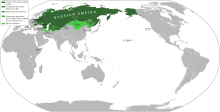 |
|
The Russian Empire as a state, existed from 1721 until it was declared a republic the 1st of September 1917. The Russian Empire was the successor to the Tsardom of Russia and the predecessor of the Soviet Union. It was one of the largest empires in world history, surpassed in landmass only by the British and Mongolian empires: at one point in 1866, it stretched from eastern Europe across Asia and into North America.
At the beginning of the 19th century the Russian Empire extended from the Arctic Ocean in the north to the Black Sea on the south, from the Baltic Sea on the west to the Pacific Ocean on the east. With 125.6 million subjects registered by the 1897 census, it had the third largest population of the world at the time, after Qing China and the British Empire. Like all empires it represented a large disparity in economic, ethnic, and religious positions. Its government, ruled by the Emperor, was one of the last absolute monarchies in Europe. Prior to the outbreak of World War I in August 1914 Russia was one of the five major Great Powers of Europe. After the October revolution it was transformed into the Soviet Union.
Following the death of the first Soviet leader, Vladimir Lenin, in 1924, Joseph Stalin eventually won a power struggle and led the country through a large-scale industrialization with a command economy and political repression. In World War II, in June 1941, Germany and its allies invaded the Soviet Union, a country with which it had signed a non-aggression pact. After four years of brutal warfare, the Soviet Union emerged victorious as one of the world's two superpowers, the other being the United States.
The Soviet Union and its Eastern European satellite states engaged in the Cold War, a prolonged global ideological and political struggle against the United States and its Western Bloc allies, which it ultimately lost in the face of economic troubles and both domestic and foreign political unrest. In the late 1980s, the last Soviet leader Mikhail Gorbachev tried to reform the state with his policies of perestroika and glasnost, but the Soviet Union collapsed and was formally dissolved in December 1991 after the abortive August coup attempt. The Russian Federation assumed its rights and obligations.
Italian Empire
- 1895–1945
The Italian colonial empire was created after the Kingdom of Italy joined other European powers in establishing colonies overseas during the "scramble for Africa". Modern Italy as a unified state only existed from 1861. By this time France, Spain, Portugal, Britain, and the Netherlands, had already carved out large empires over several hundred years. One of the last remaining areas open to colonisation was on the African continent.
By the outbreak of World War I in 1914, Italy had annexed Eritrea and Somalia, and had wrested control of portions of the Ottoman Empire, including Libya, though it was defeated in its attempt to conquer Ethiopia. The Fascist government under Italian dictator Benito Mussolini which came to power in 1922 sought to increase the size of the empire further. Ethiopia was successfully taken, four decades after the previous failure, and Italy's European borders were expanded. An official "Italian Empire" was proclaimed on 9 May 1936 following the conquering of Ethiopia. Italy sided with Nazi Germany during World War II and initially enjoyed successes. However, Allied forces eventually captured Italian overseas colonies and by the time Italy itself was invaded in 1943, its empire had all but ceased to exist.
Empire of Japan
- 1895–1945
| 大日本帝國 (Empire of Great Japan) |
|---|
 |
The Empire of Japan, officially the Empire of Great Japan or simply Great Japan (Dai Nippon), was an empire and world power that existed from the Meiji Restoration on 3 January 1868 to the enactment of the post-World War II Constitution of Japan on 3 May 1947.
Imperial Japan's rapid industrialization and militarization under the slogan Fukoku Kyōhei (富国強兵, "Enrich the Country, Strengthen the Army") led to its emergence as a world power, eventually culminating in its membership in the Axis alliance and the conquest of a large part of the Asia-Pacific region. At the height of its power in 1942, the Japanese Empire ruled over a land area spanning 7,400,000 square kilometres (2,857,000 sq mi), making it one of the largest maritime empires in history.
After winning wars against China (First Sino-Japanese War, 1894–95) and Russia (Russo-Japanese War, 1904–05) the Japanese Empire was considered to be one of the major powers worldwide. The maximum extent of the empire was gained during Second World War, when Japan conquered many Asian and Pacific countries (see Greater East Asian Co-Prosperity Sphere).
After suffering many defeats and the atomic bombings of Hiroshima and Nagasaki, however, the Empire of Japan surrendered to the Allies on 2 September 1945. A period of occupation by the Allies followed the surrender, and a new constitution was created with American involvement. The constitution came into force on 3 May 1947, officially dissolving the Empire. American occupation and reconstruction of the country continued well into the 1950s, eventually forming the current nation-state whose title is simply that ("the nation of Japan" Nippon-koku) or just "Japan".
The Emperors during this time, which spanned the entire Meiji and Taishō, and the lesser part of the Shōwa eras, are now known in Japan by their posthumous names, which coincide with those era names: Emperor Meiji (Mutsuhito), Emperor Taishō (Yoshihito), and Emperor Shōwa (Hirohito).
Today Japan is a Potential Superpower, great power, great economy and most advanced in Technology.
United States
- 1848–Present
| United States of America |
|---|
 |
While not formally an empire, the United States of America has exercised and continues to exercise worldwide economic, cultural, and military influence.
Founded in 1776 by thirteen coastal colonies that declared their independence from Great Britain, the United States began its western expansion following the end of the American Revolutionary War and the recognition of U.S. sovereignty in the 1783 Treaty of Paris. The treaty bequeathed to the nascent republic all land between the Appalachian Mountains and the Mississippi River, and Americans began migrating there in large numbers at the end of the 18th Century, resulting in the displacement of Native American cultures, often through native peoples' forcible deportation and violent wars of eviction. These efforts at expansion were greatly strengthened by the 1787 Constitutional Convention, which resulted in the ratification of the United States Constitution and transformed the U.S. from a loose confederation of semi-autonomous states into a federal entity with a strong national core. In 1803, the United States acquired Louisiana from France, doubling the country's size and extending its borders to the Rocky Mountains.
American power and population grew rapidly, so that by 1823 President James Monroe felt confident enough to issue his Monroe Doctrine, which proclaimed the Americas as the express sphere of the United States and threatened military action against any European power that attempted to make advances in the area. This was the beginning of the U.S.'s emergence as a regional power in North America. That process was confirmed in the Mexican-American War of 1846-1848, in which the United States, following a skirmish between Mexican and U.S. forces in land disputed between Mexico and the U.S., invaded Mexico. The war, which included the deployment of U.S. forces into Mexico, the taking of Veracruz by sea, and the occupation of Mexico City by American troops (which finally resulted in Mexico's defeat), stunned much of the world. In the peace treaty (Treaty of Guadelupe-Hidalgo) that followed, the U.S. annexed the northern half of Mexico, comprising what is now the Southwestern United States. During the course of the war, the United States also negotiated by treaty the acquisition of the Oregon Territory's southern half from Great Britain. In 1867, William H. Seward, the U.S. Secretary of State, negotiated the purchase of Alaska from the Russian Empire. The United States defeated Spain in the Spanish-American war in 1898, and gained the possessions of Cuba, Puerto Rico, and the Philippines. The territory of Hawaii also was acquired in 1898. the United States first became a global power in 1945 after it helped to secure victory for the allies in the Second World War; its vast economic and military resources including a short lived period of monopoly of nuclear weapons made the US one of the world's three and later two superpowers with the USSR when the British Empire had failed to maintain this position; becoming the world's sole superpower in 1990 upon the collapse of the Soviet Union. However; the length of this period of hegemony is uncertain with the growth of other possible, future superpower states such as China, Russia, Japan, or some amalgamation of states (the EU).
See also
- General topics
- History of warfare, Great power
- Political science
- Power in international relations, Expansionism (List of examples of expansionism)
- General Lists
- List of largest empires, List of countries spanning more than one continent, List of historical countries and empires spanning more than one continent, BRIC, BRICS, G8, G-20 major economies
References
- General Information
- Harrison, T., & J. Paul Getty Museum. (2009). The great empires of the ancient world. Los Angeles, Calif: J. Paul Getty Museum.
- Morris, I., & Scheidel, W. (2009). The dynamics of ancient empires: State power from Assyria to Byzantium. Oxford: Oxford University Press.
- Cooper, F. (2008). Empires and political imagination in world history. Princeton : Princeton University Press.
- Khan, A. (2004). A historical atlas of India. New York: Rosen Pub.
- Farrington, K. (2003). Historical atlas of empires. London: Mercury.
- Petitjean, P., Jami, C., Moulin, A. M., & Equipe REHSEIS (Centre national de la recherche scientifique (France)). (1992). Science and empires: Historical studies about scientific development and European expansion. Dordrecht: Kluwer Academic Publishers.
- Doyle, M. W. (1986). Empires. Ithaca, N.Y: Cornell University Press.
- Shepherd, W. R., & C.S. Hammond & Company. (1911). Historical atlas. New York: Henry Holt and Co.
- Edward Sylvester Ellis, Charles F. Horne (1906). The story of the greatest nations: from the dawn of history to the twentieth century : a comprehensive history founded upon the leading authorities, including a complete chronology of the world and a pronouncing vocabulary of each nation, Volume 1. F. R. Niglutsch.
- In Powell, T. (1888). Illustrated home book of the world's great nations: Being a geographical, historical and pictorial encyclopedia. Chicago: People's Pub. Co.
- Labberton, R. H. (1884). An historical atlas: A chronological series of one hundred and twelve maps at successive periods. New York.
- Yonge, C. M. (1882). A pictorial history of the world's great nations: From the earliest dates to the present time. New York: S. Hess.
- Labberton, R. H. (1874). An historical atlas containing a chronological series of one hundred maps. Philadelphia: Claxton, Remsen & Haffelfinger.
- Worcester, J. E. (1834). Elements of history, ancient & modern: With historical charts. Boston: Hilliard.
- Citations
- Webster, Charles K, Sir (ed), British Diplomacy 1813–1815: Selected Documents Dealing with the Reconciliation of Europe, G Bell (1931), p307.
- Toje, A. (2010). The European Union as a small power: After the post-Cold War. New York: Palgrave Macmillan.
- Edward Sylvester Ellis, Charles F. Horne (1906). The story of the greatest nations: from the dawn of history to the twentieth century : a comprehensive history founded upon the leading authorities, including a complete chronology of the world and a pronouncing vocabulary of each nation, Volume 1. F. R. Niglutsch.
- In Powell, T. (1888). Illustrated home book of the world's great nations: Being a geographical, historical and pictorial encyclopedia. Chicago: People's Pub. Co.
- Yonge, C. M. (1882). A pictorial history of the world's great nations: From the earliest dates to the present time. New York: S. Hess.
- Harrison, T., & J. Paul Getty Museum. (2009). The great empires of the ancient world. Los Angeles, Calif: J. Paul Getty Museum.
- Math in Ancient Egypt
- Society of Arts (Great Britain), Journal of the Society of Arts, Volume 26, (The Society: 1878), pp.912-913.
- John Kitto, James Taylor, The popular cyclopædia of Biblical literature: condensed from the larger work, (Gould and Lincoln: 1856), p.302.
- The Macedonian Empire: the era of warfare under Philip II and Alexander the Great, 359-323 BC. - James R.
- "A Historical Commentary on Thucydides" - David Cartwright, p. 176
- Britannica ed. 2006, "Sparta"
- Cleopatra: A Sourcebook (Oklahoma Series in Classical Culture) by Prudence J. Jones (Author) page14 (cf., “They were members of the Ptolemaic dynasty of Macedonian Greeks, who ruled Egypt after the death of its conqueror, Alexander the Great.”)
- Women in Hellenistic Egypt By Sarah B. Pomeroy page 16 “while Ptolemaic Egypt was a monarchy with a Greek ruling class."
- the Oxford Encyclopedia of Ancient Egypt. “,Cleopatra VII was born to Ptolemy XII Auletes (80–57 BCE, ruled 55–51 BCE) and Cleopatra, both parents being Macedonian Greeks.
- Encyclopedia of the Archaeology of Ancient Egypt by Kathryn Bard. page 488. (cf., "Ptolemaic kings were still crowned at Memphis and the city was popularly regarded as the Egyptian rival to Alexandria, founded by the Macedonian Greeks.”) Page 687. (cf., ”During the Ptolemaic period, when Egypt was governed by rulers of Greek descent…”)
- Timeline of Carthaginian History
- Radha Kumud Mookerji, Chandragupta Maurya and His Times, 4th ed. (Delhi: Motilal Banarsidass, 1988 ), 31, 28–33.
- Ancient India - Chandragupta Maurya
- Attention: This template ({{cite jstor}}) is deprecated. To cite the publication identified by jstor:3250228 , please use {{cite journal}} with
|jstor=3250228instead. - http://www.en.articlesgratuits.com/the-last-years-of-cholas-the-decline-and-fall-of-a-dynasty-id1804.php
- K.A. Nilakanta Sastri, A History of South India, p 5
- K.A. Nilakanta Sastri, A History of South India, p 157
- Kulke and Rothermund, p 115
- ^ Keay, p 215
- K.A. Nilakanta Sastri, A History of South India, p 158
- Majumdar, p 407
- The kadaram campaign is first mentioned in Rajendra's inscriptions dating from his 14th year. The name of the Srivijaya king was Sangrama Vijayatungavarman. K.A. Nilakanta Sastri, The CōĻas, pp 211–220
- Meyer, p 73
- K.A. Nilakanta Sastri, A History of South India, p 192
- K.A. Nilakanta Sastri, A History of South India, p 195
- K.A. Nilakanta Sastri, A History of South India, p 196
- Vasudevan, pp 20–22
- Keay, pp 217–218
- Migrations of peoples, although not strictly part of the Migration, continued beyond the period usually referred to as the Migration Period.
- Jean Paul Roux:Historie des Turcs (Trans:Prof Dr.Aykut Kazancıgil - Lale Arslan Özcan) Kabalcı yayınevi, İstanbul, 2007, ISBN 975-997-091-0, p.205-205
- "Andalus, al-" Oxford Dictionary of Islam. John L. Esposito, Ed. Oxford University Press. 2003. Oxford Reference Online. Oxford University Press. Accessed 12 June 2006.
- There is another theory about the origin of the name which states that they were called 'Bahariyya' because they came by sea or from over sea. (Shayyal, 110/vol.2 )
- (Al-Maqrizi, p. 441/vol.1 ) - (Abu Al-Fida, pp.66-87/ Year 647H - Death of as-Sailih Ayyub) - (Ibn Taghri/vol.6 - Year 639H )
- After the Castle of al- Rodah was built, As-Salih moved with his Mamluks to it and lived there. (Al-Maqrizi, p.405/vol. 1 ). Later, the Mamluk Sultans lived at the Citadel of the Mountain which was situated on the Muqatam Mountain in Cairo (Al-Maqrizi, al-Mawaiz, p. 327/vol.3 ) where the Mosque of Muhammed Ali and the remains of the Citadel (known now by the name Saladin's Citadel) stand now.
- Map of late 9th century eastern central Europe
- http://historymedren.about.com/library/text/bltxtbulgaria3.htm
- http://en.journey.bg/bulgaria/bulgaria.php?guide=100
- http://historymedren.about.com/library/text/bltxtbulgaria4.htm
- J. Meri (Hg.), Medieval Islamic Civilization: An Encyclopedia, Artikel Ghaznavids, London u.a. 2006, p. 294: "... The Ghaznavids inherited Samanid administrative, political, and cultural traditions and laid the foundations for a Persianate state in northern India. ..."
- Newman, John, The Linguistics of Eating and Drinking, (John Benjamins Publishing Company, 2009), 155.The Persianate culture was carried by succeeding dynasties into Western and Southern Asian, in particular...by the Ghaznavids..
- Meisami, Julie Scott, Persian historiography to the end of the twelfth century, (Edinburgh University Press, 1999), 143.Nizam al-Mulk also attempted to organise the Saljuq administration according to the Persianate Ghaznavid model..
- "Encyclopædia Britannica - Ghaznavid Dynasty"
- ^ C.E. Bosworth: The Ghaznavids. Edinburgh, 1963
- C.E. Bosworth, "Ghaznavids", in Encyclopaedia Iranica, Online Edition 2006, (LINK)
- ^ C.E. Bosworth, "Ghaznavids", in Encyclopaedia of Islam, Online Edition; Brill, Leiden; 2006/2007
- M.A. Amir-Moezzi, "Shahrbanu", Encyclopaedia Iranica, Online Edition, (LINK): "... here one might bear in mind that non-Persian dynasties such as the Ghaznavids, Saljuqs and Ilkhanids were rapidly to adopt the Persian language and have their origins traced back to the ancient kings of Persia rather than to Turkish heroes or Muslim saints ..."
- Encyclopaedia Iranica, Iran: Islamic Period - Ghaznavids, E. Yarshater
- B. Spuler, "The Disintegration of the Caliphate in the East", in the Cambridge History of Islam, Vol. IA: The Central islamic Lands from Pre-Islamic Times to the First World War, ed. by P.M. Holt, Ann K.S. Lambton, and Bernard Lewis (Cambridge: Cambridge University Press, 1970). pg 147: One of the effects of the renaissance of the Persian spirit evoked by this work was that the Ghaznavids were also Persianized and thereby became a Persian dynasty.
- Anatoly M Khazanov, André Wink, "Nomads in the Sedentary World", Routledge, 2padhte padhte to pagla jayega aadmi, "A History of Russia, Central Asia and Mongolia", Blackwell Publishing, 1998. pg 370: "Though Turkic in origin and, apparently in speech, Alp Tegin, Sebuk Tegin and Mahmud were all thoroughly Persianized"
- Robert L. Canfield, Turko-Persia in historical perspective, Cambridge University Press, 1991. pg 8: "The Ghaznavids (989-1149) were essentially Persianized Turks who in manner of the pre-Islamic Persians encouraged the development of high culture"
- John Perry. Iran & the Caucasus, Vol. 5, (2001), pp. 193-200. THE HISTORICAL ROLE OF TURKISH IN RELATION TO PERSIAN OF IRAN. Excerpt: “We should distinguish two complementary ways in which the advent of the Turks affected the language map of Iran. First, since the Turkish-speaking rulers of most Iranian polities from the Ghaznavids and Seljuks onward were already iranized and patronized Persian literature in their domains, the expansion of Turk-ruled empires served to expand the territorial domain of written Persian into the conquered areas, notably Anatolia and Central and South Asia. Secondly, the influx of massive Turkish-speaking populations (culminating with the rank and file of the Mongol armies) and their settlement in large areas of Iran (particularly in Azerbaijan and the northwest), progressively turkicized local speakers of Persian, Kurdish and other Iranian languages.”(John Perry. Iran & the Caucasus, Vol. 5, (2001), pp. 193-200. THE HISTORICAL ROLE OF TURKISH IN RELATION TO PERSIAN OF IRAN)
- Zahir ud-Din Mohammad (2002-09-10). Thackston, Wheeler M. (ed.). The Baburnama: Memoirs of Babur, Prince and Emperor. Modern Library Classics. ISBN 978-0-375-76137-9.
Note: Gurkānī is the Persianized form of the Mongolian word "kürügän" ("son-in-law"), the title given to the dynasty's founder after his marriage into Genghis Khan's family.
- Note: Gurgān, Gurkhān, or Kurkhān; The meaning of Kurkhan is given in Clements Markham's publication of the reports of the contemporary witness Ruy González de Clavijo as "of the lineage of sovereign princes".
- Edward Balfour The Encyclopaedia Asiatica, Comprising Indian Subcontinent, Eastern and Southern Asia, Cosmo Publications 1976, S. 460, S. 488, S. 897
- Maria Subtelny, "Timurids in Transition", BRILL; illustrated edition (2007-09-30). pg 40: "Nevertheless, in the complex process of transition, members of the Timurid dynasty and their Turko-Mongolian supporters became acculturate by the surrounding Persinate millieu adopting Persian cultural models and tastes and acting as patrons of Persian culture, painting, architecture and music." pg 41: "The last members of the dynasty, notably Sultan-Abu Sa'id and Sultan-Husain, in fact came to be regarded as ideal Perso-Islamic rulers who develoted as much attention to agricultural development as they did to fostering Persianate court culture."
- Encyclopædia Britannica, "Timurid Dynasty", Online Academic Edition, 2007. (Quotation:...Turkic dynasty descended from the conqueror Timur (Tamerlane), renowned for its brilliant revival of artistic and intellectual life in Iran and Central Asia....Trading and artistic communities were brought into the capital city of Herat, where a library was founded, and the capital became the centre of a renewed and artistically brilliant Persian culture...)
- B.F. Manz, "Tīmūr Lang", in Encyclopaedia of Islam, Online Edition, 2006
- "Timurids". The Columbia Encyclopedia (Sixth ed.). New York City: Columbia University. Retrieved 2006-11-08.
- Encyclopædia Britannica article: Consolidation & expansion of the Indo-Timurids, Online Edition, 2007.
- See, e.g., Zizhi Tongjian, vol. 196.
- Gillingham (1991), p. 124, calls it "a single, indivisible political unit throughout the middle ages"; Robinson, "Pope Gregory", p. 729.
- Furhmann, "Quis Teutonicos", p. 348.
- (Hungarian)
- "Civilization in the West", Kishlansky, Geary, Ó Brien, Volume A to 1500, Seventh Edition, pg. 278
- David Abulafia, Frederick II. A Medieval Emperor, Allen Lane the Penguin Press, 1988, ISBN 88-06-13197-
- Reu (1933), p39
- Murujul Zahab by Al Masudi (944), Kitabul Akalim by Al Istakhri (951), Ashkal-ul-Bilad by Ibn Haukal (976) (Reu 1933, p41–42)
- Chopra (2003), p89, part1; His victories were a "digvijaya" gaining only fame and booty in that region (Altekar in Kamath 2001, p75)
- From the Sanjan inscriptions, Dr. Jyotsna Kamat. "The Rashrakutas". 1996–2006 Kamat's Potpourri. Retrieved 2006-12-20.
- infopleace
- Keyes, 1995, pp.78-82
- Damian Evans (2009-04-09). "A comprehensive archaeological map of the world's largest preindustrial settlement complex at Angkor, Cambodia". PNAS. 104 (36): 14277. doi:10.1073/pnas.0702525104. PMC 1964867. PMID 17717084. Retrieved 2009-11-22.
{{cite journal}}: More than one of|pages=and|page=specified (help); Unknown parameter|coauthors=ignored (|author=suggested) (help) - Taylor, Jean Gelman (2003). Indonesia: Peoples and Histories. New Haven and London: Yale University Press. ISBN 0-300-10518-5.
- ^ "History of Madagascar". Lonely Planet.com. Retrieved 2010-07-07.
- Munoz. Early Kingdoms. p. 130.
- Munoz. Early Kingdoms. p. 140.
- "Painted Metaphors: Pottery and Politics of the Ancient Maya". University of Pennsylvania Almanac. University of Pennsylvania. 2009-04-07. Retrieved 2009-06-17.
- Terence D'Altroy, The Incas, pp. 2–3.
- Helen Chapin Metz. Iran, a Country study. 1989. University of Michigan, p. 313.
- Emory C. Bogle. Islam: Origin and Belief. University of Texas Press. 1989, p. 145.
- Stanford Jay Shaw. History of the Ottoman Empire. Cambridge University Press. 1977, p. 77.
- Andrew J. Newman, Safavid Iran: Rebirth of a Persian Empire, IB Tauris (March 30, 2006).
- Royal Netherlands Navy
- The East India Company and the British Empire in the Far East - Marguerite Eyer Wilbur, The East India Company - Google Books. Books.google.com.pk. Retrieved 2012-04-29.
- "The Mughal Empire"
- The Islamic World to 1600: Rise of the Great Islamic Empires (The Mughal Empire)
- H. Inaicik "The rise of the Ottoman Empire" in P.M. Holt, A.K. S. Lambstone, and B. Lewis (eds), "The Cambridge History of Islam" (Cambridge University). pages 295-200
- Heritage: Interactive Atlas: Polish-Lithuanian Commonwealth, last accessed on 19 March 2006 At its apogee, the Polish-Lithuanian Commonwealth comprised some 400,000 square miles (1,000,000 km) and a multi-ethnic population of 11 million. For population comparisons, see also those maps: , .
- ^ Template:En icon David Sneath (2007). The headless state: aristocratic orders, kinship society, & misrepresentations of nomadic inner Asia. Columbia University Press. p. 188. ISBN 0-231-14054-1.
{{cite book}}: Cite has empty unknown parameters:|chapterurl=and|coauthors=(help) - ^ Template:En icon M. L. Bush (1988). Rich noble, poor noble. Manchester University Press ND. pp. 8–9. ISBN 0-7190-2381-5.
{{cite book}}: Cite has empty unknown parameters:|chapterurl=and|coauthors=(help) - The Beginning Of The Swedish Empire - All Empires
- ^ Angus Maddison. The World Economy: A Millennial Perspective (p. 98, 242). OECD, Paris, 2001.
- Bruce R. Gordon. To Rule the Earth... (See Bibliography for sources used.)
- After 1866, Alaska was sold and South Sakhalin lost to Japan, but Batum, Kars, Pamir, and the Transcaspian region (Turkmenistan) were acquired. The map incorrectly shows Tuva in dark green, although in reality protectorate over Tuva was only established in 1914.
- Lowe, p.289